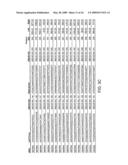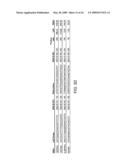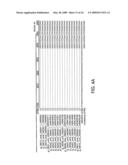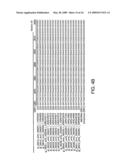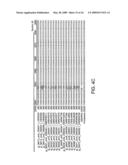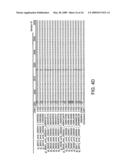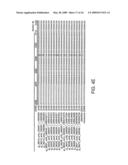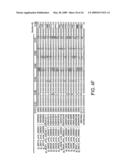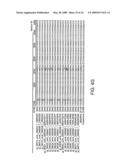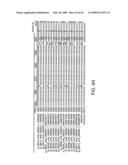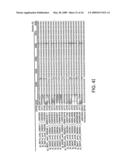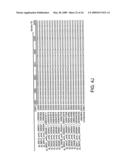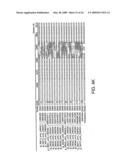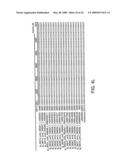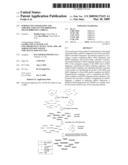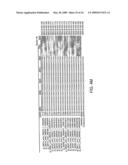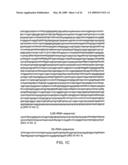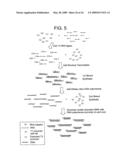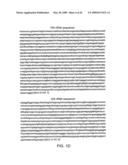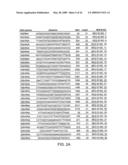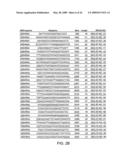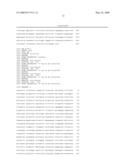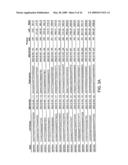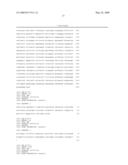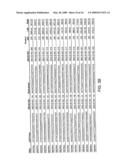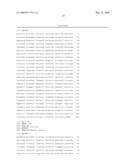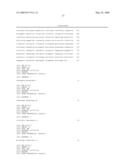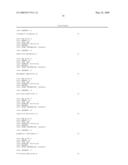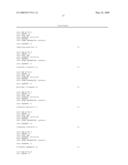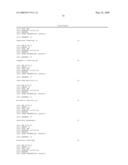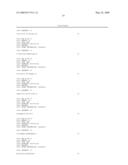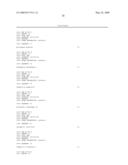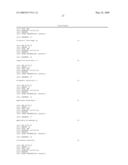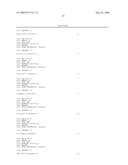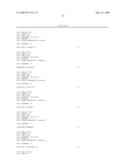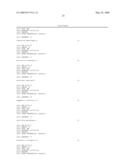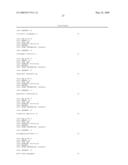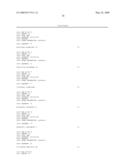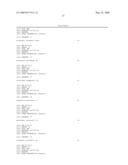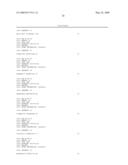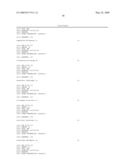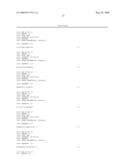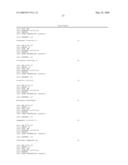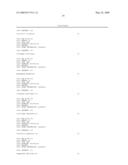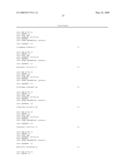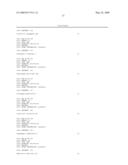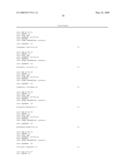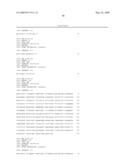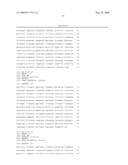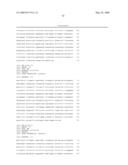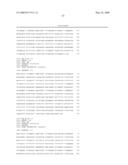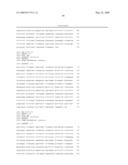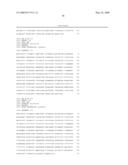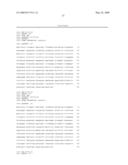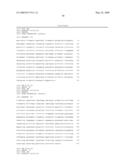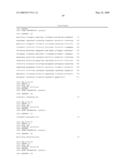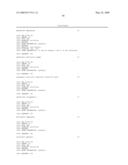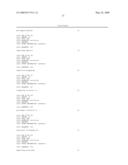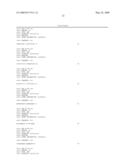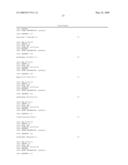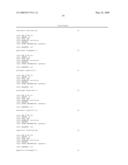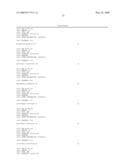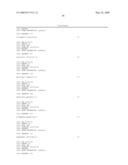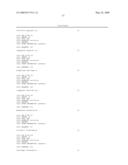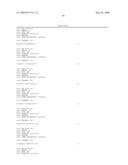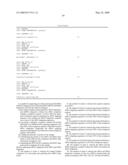Patent application title: SUBTRACTIVE SEPARATION AND AMPLIFICATION OF NON-RIBOSOMAL TRANSCRIBED RNA (nrRNA)
Inventors:
Wadiha Freije (Forest Park, IL, US)
Igor Brikun (Forest Park, IL, US)
Assignees:
EUCLID DIAGNOSTICS LLC
IPC8 Class: AC40B3004FI
USPC Class:
506 9
Class name: Combinatorial chemistry technology: method, library, apparatus method of screening a library by measuring the ability to specifically bind a target molecule (e.g., antibody-antigen binding, receptor-ligand binding, etc.)
Publication date: 2009-05-28
Patent application number: 20090137415
Claims:
1. A method of separating non-ribosomal transcribed RNA (nrRNA) fragments
from ribosomal RNA (rRNA) and rRNA fragments, wherein the method
comprises:(i) providing a sample comprising rRNA, rRNA fragments, and
nrRNA fragments, wherein the rRNA comprises multiple contiguous regions
of about 100 base pairs, each contiguous region comprising an rRNA
targeting sequence, and wherein the rRNA fragments comprise one or more
of the rRNA targeting sequences;(ii) providing a plurality of probes,
wherein the probes hybridize to (a) different RNA targeting sequences of
at least 50% of the contiguous regions of the rRNA and (b) rRNA fragments
comprising the rRNA targeting sequences hybridized to by the probes in
the contiguous regions of the rRNA;(iii) adding the plurality of probes
to the sample,(iv) hybridizing the probes to the rRNA and rRNA fragments
to form rRNA-probe complexes and rRNA fragment-probe complexes, and(v)
separating the rRNA-probe complexes and rRNA fragment-probe complexes
from the sample,thereby separating nrRNA fragments from rRNA and rRNA
fragments.
2. The method of claim 1, wherein the method further comprises (vi) recovering and purifying the nrRNA fragments.
3. The method of claim 1, wherein the sample comprises total RNA.
4. The method of claim 1, wherein the probes hybridize to rRNA targeting sequences of at least 60% of the contiguous regions.
5. The method of claim 4, wherein the probes hybridize to rRNA targeting sequences of at least 70% of the contiguous regions.
6. The method of claim 5, wherein the probes hybridize to rRNA targeting sequences of at least 80% of the contiguous regions.
7. The method of claim 6, wherein the probes hybridize to rRNA targeting sequences of at least 90% of the contiguous regions.
8. The method of claim 7, wherein the probes hybridize to rRNA targeting sequences of at least 95% of the contiguous regions.
9. The method of claim 8, wherein the probes hybridize to rRNA targeting sequences of all of the contiguous regions.
10. The method of claim 1, wherein the rRNA and the rRNA fragments comprise eukaryotic rRNA and eukaryotic rRNA fragments.
11. The method of claim 1, wherein the rRNA and rRNA fragments comprise at least two rRNAs selected from the group consisting of 28S, 18S, 5.8S, 5S, 12S and 16S rRNAs.
12. A method of amplifying nrRNA fragments, wherein the method comprises:(i) separating nrRNA fragments from rRNA and rRNA fragments according to the method of claim 1, and(ii) amplifying the nrRNA fragments.
13. A method of analyzing nrRNA expression, wherein the method comprises:(i) separating nrRNA fragments from rRNA and rRNA fragments according to the method of claim 1, and(ii) analyzing nrRNA expression.
14. A method of amplifying a cDNA complementary to an nrRNA fragment, wherein the method comprises:(i) separating an nrRNA fragment from rRNA and rRNA fragments according to the method of claim 1, wherein the nrRNA fragment comprises a 5' end;(ii) ligating a first oligonucleotide to the 5' end of the nrRNA fragment;(iii) hybridizing to the nrRNA fragment a second oligonucleotide;(iv) extending a DNA strand from the second oligonucleotide to generate a first cDNA;(v) amplifying the first cDNA,thereby amplifying a cDNA complementary to an nrRNA fragment.
15. A method of amplifying an nrRNA fragment, wherein the method comprises:(i) separating an nrRNA fragment from rRNA and rRNA fragments according to the method of claim 1, wherein the nrRNA fragment comprises a 5' end and a 3' end;(ii) ligating a first oligonucleotide to the 5' end of the nrRNA fragment;(iii) hybridizing to the nrRNA fragment a second oligonucleotide;(iv) extending a DNA strand from the second oligonucleotide to generate a first cDNA having a 5' end and a 3' end;(v) degrading the nrRNA fragment and, optionally, removing any free oligonucleotides and/or free RNA fragments;(vi) synthesizing a complementary strand to the first cDNA by(a) contacting the first cDNA with a third oligonucleotide such that the third oligonucleotide hybridizes to the 3' end of the first cDNA, wherein the third oligonucleotide hybridizes to at least a portion of the first oligonucleotide and wherein the third oligonucleotide optionally contains an RNA polymerase promoter sequence, and(b) extending the complementary strand from the third oligonucleotide, whereupon a double-stranded DNA copy of the nrRNA fragment is generated;(vii) optionally purifying the double-stranded DNA copy; and(viii) transcribing RNA from the double-stranded DNA copy,thereby amplifying the nrRNA fragment.
16. The method of claim 15, wherein the second oligonucleotide comprises a unique sequence, a random sequence, and, optionally, an RNA polymerase promoter sequences, wherein the random sequence is of sufficient length to hybridize to the nrRNA.
17. A method of determining the level of nrRNA in a sample, wherein the method comprises:(i) separating nrRNA fragments from rRNA and rRNA fragments according to the method of claim 1;(ii) labeling the separated nrRNA fragments with a detectable label;(iii) providing an array comprising a collection of fixed DNAs that hybridize to a plurality of target sequences located within an expression sequence of a gene of interest, wherein the fixed DNAs comprise from about 15 nucleotides to about 750 nucleotides, wherein at least one target sequence is interspersed approximately every 500 base pairs of the expression sequence;(iv) applying the labeled nrRNA fragments to the array under hybridization conditions;(v) optionally removing unbound and nonspecifically bound nrRNA fragments from the array;(vi) detecting the labeled nrRNA fragments that have specifically annealed to the fixed DNAs in the array; and(vii) quantitating the level of labeled nrRNA fragments detected in step (vi) to thereby determine the level of nrRNA in the sample.
18. The method of claim 17, wherein the method further comprises (viii) correlating the level of nrRNA to a level of expression of the gene of interest.
19. A kit for separating non-ribosomal transcribed RNA (nrRNA) fragments from a sample comprising ribosomal RNA (rRNA) and rRNA fragments, wherein the kit comprises a plurality of probes that hybridize to (a) different rRNA target sequences of at least 50% of contiguous regions of about 100 base pairs of the rRNA, which contiguous regions comprise the rRNA targeting sequences and (b) rRNA fragments comprising the rRNA targeting sequences hybridized to by the probes in the contiguous regions of the rRNA.
20. The kit of claim 19, wherein the probes hybridize to rRNA targeting sequences of at least 60% of the contiguous regions.
21. The kit of claim 20, wherein the probes hybridize to rRNA targeting sequences of at least 70% of the contiguous regions.
22. The kit of claim 21, wherein the probes hybridize to rRNA targeting sequences of at least 80% of the contiguous regions.
23. The kit of claim 22, wherein the probes hybridize to rRNA targeting sequences of at least 90% of the contiguous regions.
24. The kit of claim 23, wherein the probes hybridize to rRNA targeting sequences of at least 95% of the contiguous regions.
25. The kit of claim 24, wherein the probes hybridize to rRNA targeting sequences of all of the contiguous regions.
26. The kit of claim 19, wherein the rRNA and rRNA fragments comprise eukaryotic rRNA and eukaryotic rRNA fragments.
27. The kit of claim 19, wherein the rRNA and rRNA fragments comprise 28S, 18S, 5.8S, 5S, 16S, and 12S rRNAs or fragments thereof.
28. The kit of claim 19 further comprising instructions.
29. A system for separating non-ribosomal transcribed RNA (nrRNA) fragments from a sample comprising ribosomal RNA (rRNA) and rRNA fragments, the system comprising:(i) a device adapted for the separation of nucleic acids by hybridization; and(ii) a plurality of probes that hybridize to (a) different rRNA target sequences of at least 50% of contiguous regions of about 100 base pairs of the rRNA, which contiguous regions comprise the rRNA targeting sequences, and (b) rRNA fragments comprising the rRNA targeting sequences hybridized to by the probes in the contiguous regions of the rRNA, wherein the plurality of probes is positioned within the device to separate the rRNA and rRNA fragments from nrRNA.
30. The system of claim 29, wherein the probes hybridize to rRNA targeting sequences of at least 60% of the contiguous regions.
31. The system of claim 30, wherein the probes hybridize to rRNA targeting sequences of at least 70% of the contiguous regions.
32. The system of claim 31, wherein the probes hybridize to rRNA targeting sequences of at least 80% of the contiguous regions.
33. The system of claim 32, wherein the probes hybridize to rRNA targeting sequences of at least 90% of the contiguous regions.
34. The system of claim 33, wherein the probes hybridize to rRNA targeting sequences of at least 95% of the contiguous regions.
35. The system of claim 34, wherein the probes hybridize to rRNA targeting sequences of all of the contiguous regions.
36. The system of claim 29, wherein the rRNA and rRNA fragments comprise 28S, 18S, 5.8S, 5S, 16S, and 12S rRNAs or fragments thereof.
Description:
CROSS-REFERENCE TO RELATED APPLICATIONS
[0001]This patent application claims the benefit of U.S. Provisional Patent Application No. 60/705,964, filed Aug. 5, 2005.
TECHNICAL FIELD OF THE INVENTION
[0002]The invention relates to methods comprising separating messenger RNA (mRNA) and/or non-coding RNA (ncRNA), referred to collectively herein as non-ribosomal transcribed RNA (nrRNA), from a sample, such as a sample of total RNA. The invention also relates to kits and systems for use in such methods.
BACKGROUND OF THE INVENTION
[0003]Most mRNA isolation kits rely on the oligo dT-mediated purification of mRNA. This method is disadvantageous when mRNA is degraded and, hence, fragmented. The oligo dT only binds to the polyA tail of mRNA and, therefore, only purifies intact mRNA and molecules of mRNA that contain polyA tails. Molecules of mRNA that do not contain polyA tails are not purified. For this reason, when performing expression analysis using RNA isolated from fixed tissues, scientists have relied on the reverse transcription of total RNA using random hexamers even though over 95% of the RNA present in the sample is ribosomal (Godfrey et al., J. Molec. Diagnostics 2(2): 84-91 (2000)). This approach is disadvantageous because it is not sensitive and does not enable optimal detection of mRNA present in low copy numbers.
[0004]To overcome this limitation, scientists have used oligonucleotide primers designed to anneal to a plurality of genes for the reverse transcription reaction (see, for example, U.S. Patent Application Publication Nos. 2004/0259105 and 2005/0095634). Using this approach, only the expression level of a limited number of genes can be determined. Furthermore, only small portions of those genes, which are upstream of the primer site, can be analyzed, since the majority of the RNA fragments are less than 500 base pairs in length. In addition, if the fragments are very short, such as less than 50 base pairs, it may be extremely difficult to design an assay to determine expression levels, whether by polymerase chain reaction, ligation-mediated amplification, or microarray analysis, for example.
[0005]Murphy and Whitley (U.S. Patent Application Publication No. 2003/0175709 and International Patent Application Publication No. WO 03/054162) have proposed the use of a bridging nucleic acid, which includes at least one targeting region and at least one bridging region, and a capture nucleic acid, which includes a capture region and a non-reacting structure. The targeting region is complementary to a targeted region of a targeted nucleic acid to be removed. The bridging region is complementary to the capture region. The nonreacting structure is a compound that does not react with a nucleic acid. The bridging nucleic acid can include up to 10 or more targeting regions that are complementary to different, non-overlapping targeted regions from the same or different targeted nucleic acids. This method is disadvantageous in that the use of multiple targeting regions on a single bridging nucleic acid can decrease the efficiency of hybridization between the targeting regions and the complementary targeted regions. In addition, the use of multiple targeting regions on a single bridging nucleic acid can interfere with hybridization between the bridging region of the bridging nucleic acid and the capture region of the capture nucleic acid. These effects also can decrease efficiency of recovery of non-ribosomal RNA. The methods disclosed by Murphy and Whitley also result in increased background hybridization due to the length of the oligonucleotides used.
[0006]The invention seeks to overcome the disadvantages of the currently available isolation kits by providing a method that enables the purification of nrRNA fragments that do not contain polyA tails as well as intact mRNA and/or ncRNA. This and other objects and advantages of the invention, as well as additional inventive features, will become apparent from the detailed description provided herein.
BRIEF SUMMARY OF THE INVENTION
[0007]The invention provides a method of separating non-ribosomal transcribed RNA (nrRNA) fragments from ribosomal RNA (rRNA) and rRNA fragments. The method comprises (i) providing a sample comprising rRNA, rRNA fragments, and nrRNA fragments, wherein the rRNA comprises multiple contiguous regions of about 100 base pairs. Each contiguous region comprises an rRNA targeting sequence, and the rRNA fragments comprise one or more of the rRNA targeting sequences. The method further comprises (ii) providing a plurality of probes. The probes hybridize to (a) different RNA targeting sequences of at least 50% of the contiguous regions of the rRNA and (b) rRNA fragments comprising the rRNA targeting sequences hybridized to by the probes in the contiguous regions of the rRNA. The method further comprises (iii) adding the plurality of probes to the sample, (iv) hybridizing the probes to the rRNA and rRNA fragments to form rRNA-probe complexes and rRNA fragment-probe complexes, and (v) separating the rRNA-probe complexes and rRNA fragment-probe complexes from the sample, thereby separating nrRNA fragments from rRNA and rRNA fragments.
[0008]The invention further provides a method of amplifying a cDNA complementary to an nrRNA fragment. The method comprises (i) separating an nrRNA fragment from rRNA and rRNA fragments according to the inventive method, wherein the nrRNA fragment comprises a 5' end. The method also comprises (ii) ligating a first oligonucleotide to the 5' end of the nrRNA fragment, (iii) hybridizing to the nrRNA fragment a second oligonucleotide, (iv) extending a DNA strand from the second oligonucleotide to generate a first cDNA, and (v) amplifying the first cDNA, thereby amplifying a cDNA complementary to an nrRNA fragment.
[0009]In addition, the invention provides a method of amplifying nrRNA fragments. The method comprises (i) separating nrRNA fragments from rRNA and rRNA fragments according to the inventive method. The method further comprises (ii) amplifying the nrRNA fragments. Alternatively, the method further comprises (ii) ligating a first oligonucleotide to the 5' end of the nrRNA fragment; (iii) hybridizing to the nrRNA fragment a second oligonucleotide; and (iv) extending a DNA strand from the second oligonucleotide to generate a first cDNA having a 5' end and a 3' end. The method then comprises (v) degrading the nrRNA fragment and, optionally, removing any free oligonucleotides and/or free RNA fragments; (vi) synthesizing a complementary strand to the first cDNA; (vii) optionally purifying the double-stranded DNA copy; and (viii) transcribing RNA from the double-stranded DNA copy. Synthesizing a complementary strand to the first cDNA in step (vi) comprises (a) contacting the first cDNA with a third oligonucleotide such that the third oligonucleotide hybridizes to the 3' end of the first cDNA and (b) extending the complementary strand from the third oligonucleotide, whereupon a double-stranded DNA copy of the nrRNA fragment is generated. The third oligonucleotide hybridizes to at least a portion of the first oligonucleotide and optionally contains an RNA polymerase promoter sequence.
[0010]Still further provided by the invention is a method of analyzing nrRNA expression. The method comprises (i) separating nrRNA fragments from rRNA and rRNA fragments according to the inventive method and (ii) analyzing nrRNA expression. Additionally, the invention provides a method of determining the level of nrRNA in a sample. The method comprises (i) separating nrRNA fragments from rRNA and rRNA fragments according to the inventive method and (ii) labeling the separated nrRNA fragments with a detectable label. The method of determining the level of nrRNA in a sample further comprises (iii) providing an array comprising a collection of fixed DNAs that hybridize to a plurality of target sequences located within an expression sequence of a gene of interest. The fixed DNAs comprise from about 15 nucleotides to about 750 nucleotides, and at least one target sequence is interspersed approximately every 500 base pairs of the expression sequence. The method additionally comprises (iv) applying the labeled nrRNA fragments to the array under hybridization conditions; (v) optionally removing unbound and nonspecifically bound nrRNA fragments from the array; (vi) detecting the labeled nrRNA fragments that have specifically annealed to the fixed DNAs in the array; and (vii) quantitating the level of labeled nrRNA fragments detected in step (vi) to determine the level of nrRNA in the sample.
[0011]The invention also provides a kit for separating nrRNA fragments from a sample comprising rRNA and rRNA fragments. The kit comprises a plurality of probes that hybridize to (a) different rRNA target sequences of at least 50% of contiguous regions of about 100 base pairs of the rRNA, which contiguous regions comprise the rRNA targeting sequences and (b) rRNA fragments comprising the rRNA targeting sequences hybridized to by the probes in the contiguous regions of the rRNA. Preferably, the kit also comprises instructions.
[0012]Likewise, the invention provides a system for separating nrRNA fragments from a sample comprising rRNA and rRNA fragments. The system comprises a device adapted for the separation of nucleic acids by hybridization. The system also comprises a plurality of probes that hybridize to (a) different rRNA target sequences of at least 50% of contiguous regions of about 100 base pairs of the rRNA, which contiguous regions comprise the rRNA targeting sequences, and (b) rRNA fragments comprising the rRNA targeting sequences hybridized to by the probes in the contiguous regions of the rRNA. The plurality of probes is positioned within the device to separate the rRNA and rRNA fragments from nrRNA.
BRIEF DESCRIPTION OF THE FIGURES
[0013]FIGS. 1A-1D show the nucleotide sequences of the 28S (SEQ ID NO: 1), 18S (SEQ ID NO: 2), 5.8S (SEQ ID NO: 3), 5S (SEQ ID NO: 4), 16S (SEQ ID NO: 5), and 12S (SEQ ID NO: 6) rRNAs. Sequences are presented from left to right, top to bottom, in accordance with convention.
[0014]FIGS. 2A-2D show a set of oligonucleotides (SEQ ID NOs: 7-110) that can hybridize to rRNA and are suitable for use in the method. The "Start" positions are given relative to the sequences of FIGS. 1A-1D.
[0015]FIGS. 3A-3C show a set of forward and reverse primers (SEQ ID NOs: 111-165 and 191-245) that can amplify fragments corresponding to six rRNA species. The "Left" and "Right" designations indicate forward and reverse primers, respectively.
[0016]FIGS. 4A-4M compare 28S rRNA sequences and provide the consensus sequence (SEQ ID NOs: 166-184).
[0017]FIG. 5 is a diagram illustrating the preparation of double-stranded cDNA for amplification.
DETAILED DESCRIPTION OF THE INVENTION
[0018]The invention is predicated on the discovery that the use of an exhaustive set of probes enables the efficient removal of ribosomal RNA (rRNA) (i.e., intact rRNA and/or rRNA fragments) from a sample of total RNA. In doing so, the invention enables the separation and/or purification and/or enrichment of non-ribosomal transcribed RNA (nrRNA) fragments that do not contain polyA tails, such as are commonly found in degraded RNA. The invention does not suffer from the disadvantages attendant the use of currently available methods.
[0019]The invention provides a method of separating nrRNA, such as messenger RNA (mRNA) and non-coding RNA (ncRNA), from a sample, such as a sample comprising total RNA. The inventive method can be performed on any sample suitable for separation of RNA species. Indeed, any suitable sample of, for example, total RNA can be used. Preferably, degradation of RNA in the sample has been minimized. However, the invention is advantageous in that it can be used on degraded RNA, such as RNA recovered from preserved tissue samples, e.g., paraffin-embedded tissue samples, biopsies, surgical specimens, and any other source containing degraded RNA. Such RNA is usually less than 500 base pairs in size and may not represent the entire population of mRNA species present in original tissue samples. The invention also permits the recovery of ncRNA species that are present in a total RNA sample, such as small interfering RNA (siRNA) and small nuclear RNA (snRNA). Researchers have great difficulty in efficiently isolating such small RNA species using currently known methods.
[0020]The method comprises (i) removing rRNA from the sample of total RNA by hybridizing the rRNA with a plurality of probes comprising at least one probe that can hybridize to a complementary sequence within about 100 contiguous base pairs of the rRNA to be removed such that at least one probe hybridizes to a complementary sequence within at least about every 100 contiguous base pairs of the rRNA to be removed, and (ii) purifying the nrRNA.
[0021]Alternatively, the invention provides a method of separating nrRNA fragments from rRNA and rRNA fragments. The method comprises: (i) providing a sample comprising rRNA, rRNA fragments, and nrRNA fragments; (ii) providing a plurality of probes; (iii) adding the plurality of probes to the sample; (iv) hybridizing the probes to the rRNA and rRNA fragments to form rRNA-probe complexes and rRNA fragment-probe complexes, and (v) separating the rRNA-probe complexes and rRNA fragment-probe complexes from the sample (i.e., separating the hybridized RNA from the sample of RNA). Optionally, simultaneously with or subsequently to removing rRNA from the sample (e.g., the sample of total RNA), the method can further comprise removing any other RNA that is not of interest, such as unwanted mRNA species that are abundantly expressed or tRNA(s). It will be understood that "separating" the rRNA-probe complexes and/or rRNA fragment-probe complexes (or any other RNA) from the sample does not require complete elimination of rRNA or rRNA fragments from the sample. If desired, additional rounds of hybridization in accordance with the inventive method can be performed to further remove unwanted RNA. For example, the method can be performed on a sample of total RNA to achieve a sample comprising no more than 20% rRNA. Preferably, the method yields a sample or composition comprising no more than 10% rRNA, and more preferably the resulting composition comprises no more than 5% rRNA. Most preferably, the composition resulting from the inventive method comprises no more than 1% rRNA. The inventive method preferably further comprises (vi) recovering and purifying the nrRNA fragments. In view of the above, the method is particularly suited for enriching a composition for nrRNA and fragments thereof by removing unwanted RNAs, such as rRNA and rRNA fragments.
[0022]The invention comprises employing a plurality of probes to saturate unwanted rRNA in a sample, thereby providing multiple "handles" for removing the unwanted material using any suitable separation technique. In this regard, rRNA and rRNA fragments can be conceptually divided into multiple contiguous regions of about 100 base pairs. For example, an rRNA or rRNA fragment that comprises 1000 base pairs comprises ten contiguous regions of about 100 base pairs. Each contiguous region comprises one or more RNA targeting sequences. Preferably, two or more of the multiple contiguous regions comprise different rRNA targeting sequences. An "rRNA targeting sequence" refers to a nucleotide sequence within the rRNA or rRNA fragment that is complementary to, and thereby hybridizes with, one or more probes of the plurality. The rRNA fragments of the sample desirably comprise one or more of the rRNA targeting sequences.
[0023]A "plurality of probes" is a collection of molecules, such as oligonucleotides, that bind rRNA target sequences within the rRNA or rRNA fragments of the sample. Preferably, the probes hybridize to (a) different RNA targeting sequences of at least 50% of the contiguous regions of the rRNA and (b) rRNA fragments comprising the rRNA targeting sequences hybridized to by the probes in the contiguous regions of the rRNA. In other words, if an rRNA comprises ten contiguous regions of about 100 base pairs, the probes hybridize to RNA targeting sequences in at least five of the ten contiguous regions. By "different" RNA targeting sequences is meant separate, individual RNA targeting sequences, which may or may not be unique. Desirably, multiple probes hybridize over the length of the unwanted RNA to ensure efficient removal. For example, the probes of the inventive method can hybridize to rRNA targeting sequences of at least 60% of the contiguous regions (e.g., the probes hybridize to rRNA targeting sequences of at least 70% of the contiguous regions). Even more preferably, the probes hybridize to rRNA targeting sequences of at least 80% of the contiguous regions (e.g., the probes hybridize to rRNA targeting sequences of at least 90% of the contiguous regions). Still more preferably, the probes hybridize to rRNA targeting sequences of at least 95% of the contiguous regions. Even more preferably, the probes hybridize to rRNA targeting sequences of all of the contiguous regions (i.e., rRNA targeting sequences located in each and every contiguous region).
[0024]In this regard, rRNA and fragments thereof and, optionally, any other RNA that is not of interest, can be removed from a sample, e.g., a sample of total RNA, by hybridizing the RNA to a plurality of probes comprising, for example, at least one tagged oligonucleotide (i.e., DNA or RNA, including modified base analogs), tagged single-stranded nucleic acid molecule (i.e., DNA or RNA), or tagged DNA mimic, such as a locked nucleic acid (LNA; Koshkin et al., Tetrahedron 54: 3607-3630 (1998); Koshkin et al., JACS 120: 13252-13253 (1998); and Wahlestedt et al., PNAS 97: 5633-5638 (2000)) and/or a DNA analog with a non-phosphodiester backbone (such as a peptide nucleic acid (PNA; Nielson, Molec. Biotech. 26: 233-248 (2004); and Egholm et al., Nature 365(6446): 566-568 (1993)) or morpholino derivatives (Summerton, BioChim. Biophys. Acta 1489:141-158 (1999)), which is complementary to the RNA that is to be removed.
[0025]The rRNA and the rRNA fragments in the sample can comprise eukaryotic rRNA and eukaryotic rRNA fragments, although a sample also can comprise bacterial RNA species. In addition, the probes, including any tagged oligonucleotides, tagged single-stranded nucleic acid molecules, and/or DNA mimics, can be complementary to 18S, 28S, 5S, 5.8S, 12S, or 16S rRNA (see FIGS. 1A-1D and 2A-2D). The sequences of different rRNA species are highly conserved; however, the probes (e.g., oligonucleotides or molecules complementary to the rRNA species) can contain sequences complementary to polymorphic regions within the rRNA sequences to maximize removal of rRNA species from the sample (see, e.g., FIGS. 4A-4M for examples of such polymorphic regions). Such probes (e.g., oligonucleotides and/or molecules complementary to the rRNA species) can be used in various combinations. The rRNA and rRNA fragments can comprise at least two rRNAs selected from the group consisting of 28S, 18S, 5.8S, 5S, 12S, and 16S rRNAs. Thus, the plurality of probes can comprise one that is complementary to 18S rRNA and another that is complementary to 28S rRNA. Under certain circumstances, such as when an nrRNA of interest is present in low copy number, it can be desirable to remove unwanted RNA fragments that are abundant in the sample. It may be desirable to use an additional oligonucleotide and/or single-stranded nucleic acid molecule probe in addition to probes that are complementary to 18S and 28S, such as one or more or even all of 12S, 16S, 5.8S, and 5S rRNAs, alone or in further combination with probes (such as an oligonucleotide, a single-stranded nucleic molecule and/or a DNA mimic) that are complementary to tRNA and/or that are complementary to any mRNA that may be abundantly expressed in the RNA sample under investigation and that is not of interest.
[0026]Probes (e.g., oligonucleotide probes) can be synthesized using any in vitro chemical synthesis known in the art. Oligonucleotide probes can be as short as around 12 nucleotides or as long as around 150 nucleotides, such as around 15 or 17 nucleotides up to around 100 nucleotides, whereas a single-stranded nucleic acid molecule probe can be as short as 75 nucleotides up to the full-length of the RNA molecule that it complements. Oligonucleotides can be selected using a Primer selection program (e.g., Vector NTI (Invitrogen, Carlsbad Calif.) or Primer 3 (Rozen et al., "Primer 3 on the WWW for general users and for biologist programmers." In: Krawetz and Misener, eds. Bioinformatics Methods and Protocols, Methods in Molecular Biology. Humana Press, Totowa, N.J. (2000), pp. 365-386)) using suitable parameters for primer length, base composition, and melting temperatures. It is preferred that the oligonucleotide probe have a GC content of about 35-80%, and a melting temperature of about 50-75° C. The optimal oligonucleotide length and melting temperature for the probes can be determined by the composition of the buffers used for the hybridization. Primer design programs select oligonucleotides based on the user's input of relevant parameters, including minimizing secondary structures, palindromic sequences, and hairpin loops. The oligonucleotides can be further analyzed by sequence homology search programs (e.g., BLAST) to minimize cross-hybridization to other genomic sequences, especially homology to expressed transcripts. It is preferred that the set of oligonucleotides used as probes for the hybridization contain at least one oligonucleotide complementary to each fragment (i.e., contiguous region) of the rRNA, wherein each fragment (i.e., contiguous region) is from about 100 base pairs to about 250 base pairs.
[0027]Single-stranded nucleic acid molecules can be synthesized in vitro (i.e., PCR or transcription-coupled amplification) or in vivo (i.e., replicated in living cells using recombinant DNA vectors). Such molecules can be synthesized as fragments or full-length molecules, and can be employed as probes in the context of the invention.
[0028]The probes of the invention can be tagged. By "tagged" is meant adding a molecule (a "tag") to the probe (e.g., oligonucleotide, single-stranded nucleic acid molecule, and/or DNA mimic) that will permit downstream manipulations, such as removal. For example, the tag can be biotin, which, upon binding to streptavidin, such as streptavidin attached to a support (e.g., a magnetic bead or plastic surface), results in the removal of rRNA and any other RNA that is not of interest from the sample. Alternatively, the tag can be digoxygenin, which, upon binding to an immobilized anti-digoxygenin antibody, such as an antibody attached to a substrate (e.g., a magnetic bead or a microtiter plate), results in the removal of rRNA and any other RNA that is not of interest from the sample. Alternatively, the tag can be an amine linker that can be used to immobilize the oligonucleotide on a solid support.
[0029]The method of the invention comprises hybridizing the probes to the rRNA and rRNA fragments to form rRNA-probe complexes and rRNA fragment-probe complexes, which are then separated from the sample. Hybridization refers to the annealing of single stranded oligonucleotides to form double stranded oligonucleotides in an environment below the melting temperature of the double stranded oligonucleotide. Hybridization conditions are well known in the art and can be adapted to accommodate specific probes, rRNA sequences, and desired level of specificity of unwanted RNA removal. In this regard, "stringency" of hybridization reactions is determined by probe length, homology between the sequences, washing temperature, and salt concentration. In general, longer probes require higher temperatures for proper annealing, while shorter probes need lower temperatures. In addition, the higher the degree of homology between the probe and rRNA or rRNA fragment, the higher the relative temperature that can be used. Hybridization reactions are further described in, for example, Ausubel et al., Current Protocols in Molecular Biology, Wiley Interscience Publishers, (1995), and U.S. Pat. No. 7,081,340.
[0030]The hybridization conditions can include, but are not limited to, "stringent conditions" or "high stringency conditions" which typically: (1) employ low ionic strength and high temperature for washing, for example 0.015 M sodium chloride/0.0015 M sodium citrate/0.1% sodium dodecyl sulfate at 50° C.; (2) employ, during hybridization, a denaturing agent, such as formamide (e.g., 50% (v/v) formamide), 50 mM sodium phosphate buffer at pH 6.5 with 750 mM sodium chloride, 75 mM sodium citrate at 42° C.; or (3) employ 50% formamide, 5×SSC (0.75 M NaCl, 0.075 M sodium citrate), 50 mM sodium phosphate (pH 6.8), 0.1% sodium pyrophosphate, optionally followed by a high-stringency wash consisting of 0.1×SSC containing EDTA at 55° C.
[0031]"Moderately stringent conditions" are described in, e.g., Sambrook et al., Molecular Cloning: A Laboratory Manual, New York: Cold Spring Harbor Press, 1989. Moderately stringent conditions can be achieved using a washing solution and hybridization conditions (e.g., temperature and ionic strength) less stringent that those described above. For example, moderately stringent conditions can comprise an overnight incubation at 37° C. in a solution comprising: 20% formamide, 5×SSC (150 mM NaCl, 15 mM trisodium citrate), 50 mM sodium phosphate (pH 7.6). The skilled artisan will recognize how to adjust the temperature, ionic strength, etc. as necessary to accommodate factors such as probe length and the like. DNA recovered in the remaining wash buffer can be added to the original hybridization mix, and hybridization can be repeated to further reduce the amount of rRNA in the sample. If desired, the rRNA of the sample is discarded, and the nrRNA is recovered in the hybridization buffer. In this regard, the hybridization step of the inventive method can be repeated to reduce the concentration of unwanted RNA, such as unwanted rRNA or rRNA fragments, in the sample. The hybridization step can be repeated by administering fresh probes to the reaction to form additional rRNA-probe complexes and rRNA fragment-probe complexes with the residual rRNA and rRNA fragments that may remain in the sample. Further reducing the concentration of rRNA and rRNA fragments further enriches the composition with desired nrRNA.
[0032]In view of the above, the invention further provides a composition comprising mRNA, which has been separated from a sample of total RNA and which includes N-terminal and/or internal molecules of mRNA. "N-terminal molecule of mRNA" means a molecule of mRNA that includes the transcription start site. "Internal molecule of mRNA" means a molecule of mRNA that does not include the transcription start site or the polyA tail. The mRNA can be amplified.
[0033]Also provided by the invention is an improved method of amplifying nrRNA fragments (such as mRNA or fragments thereof). The method comprises (i) separating nrRNA fragments from rRNA and rRNA fragments according to the inventive method described herein, and (ii) amplifying the nrRNA fragments. The improvement provided by the invention comprises using either of (i) nrRNA that has been separated from a sample of total RNA in accordance with the above-described method or (ii) the above-described composition. Although the inventive method enriches a sample for desired nrRNA, the composition can be further enriched with desired nrRNA by amplifying the nrRNA fragments in the resulting composition. The amplification of RNA, and oligonucleotides in general, has been the subject of numerous patents (see, e.g., U.S. Pat. Nos. 5,545,522; 5,716,785; 6,291,170; 6,642,034; 6,593,086; and 6,794,141, and U.S. Patent Application Publication No. 2005/0009101). Examples of methods that can be used to amplify mRNA include, but are not limited to, concatenation of RNA fragments, reverse transcription to generate the first cDNA strand, and strand displacement amplification; and attachment of an RNA polymerase promoter to the first or second strand cDNA followed by a transcription reaction to generate a multitude of copies of the starting cDNAs. A promoter is a sequence that can be recognized and bound by an RNA polymerase with subsequent transcription of the DNA fragment that is located downstream of the 3' end of the promoter. Examples of such promoters include, but are not limited to, the T3, T4, T7, SP6, and Q beta replicase promoters.
[0034]The invention further provides an improved method of performing expression analysis of nrRNA. The method of analyzing nrRNA expression comprises (i) separating nrRNA fragments from rRNA and rRNA fragments according to the inventive method described herein and (ii) analyzing nrRNA expression. Examples of methods that can be used to perform expression analysis include, but are not limited to, PCR, quantitative PCR, and microarrays (PCR protocols, Bartlett et al., eds. Humana Press, Totowa, N.J. (2003); RT-PCR protocols, O'Connell, ed. Humana Press (2002); Gene cloning and analysis by RT-PCR, Siebert et al., eds. Eaton Publishing, Natick, Mass. (1998); A-Z quantitative PCR, Bustin, ed. IUL press, LaJolla, Calif. (2004); DNA microarrays: Gene expression applications, Jordan, ed. Springer-Verlag, New York, N.Y. (2001); Microarrays Methods and Applications: Nuts and Bolts, Hardiman, ed. DNA Press, Eagleville, Pa. (2003); and Guide to analysis of microarray data, 2nd ed., Knudsen, ed. Wiley & Sons, Indianapolis, Ind. (2004)). The improvement provided by the invention comprises using either of (i) mRNA that has been separated from a sample of total RNA in accordance with the above-described method or (ii) the above-described composition.
[0035]A kit is also provided by the invention. The kit comprises instructions and at least one reagent for separating nrRNA from a sample of total RNA by (i) removing rRNA from the sample of total RNA, and, optionally, simultaneously or subsequently removing any other RNA that is not of interest, and (ii) purifying the nrRNA. The at least one reagent can comprise at least one oligonucleotide, single-stranded nucleic acid molecule, or DNA mimic that is complementary to (i) an rRNA selected from the group consisting of 18S, 28S, 12S, 16S, 5.8S and 5S and/or (ii) a tRNA.
[0036]In addition, the invention provides a kit for separating nrRNA fragments from a sample comprising rRNA and rRNA fragments (e.g., eukaryotic rRNA and eukaryotic rRNA fragments). Preferably, the rRNA and rRNA fragments comprise 28 S, 18 S, 5.8 S, 5S, 16S, and 12S rRNAs or fragments thereof. The inventive kit comprises a plurality of probes that hybridize to different rRNA target sequences of at least 50% of contiguous regions of about 100 base pairs of the rRNA, which contiguous regions comprise the rRNA targeting sequences. The plurality of probes also hybridize to rRNA fragments comprising the rRNA targeting sequences hybridized to by the probes in the contiguous regions of the rRNA. The kit also, optionally, further comprises instructions.
[0037]To increase specificity and efficiency of removal of unwanted rRNA from the sample, the probes of the kit preferably hybridize to rRNA targeting sequences of at least 60% of the contiguous regions (more preferably at least 70% of the contiguous regions). More preferably, the probes hybridize to rRNA targeting sequences of at least 80% of the contiguous regions (e.g., at least 90% of the contiguous regions). Even more preferably, the probes hybridize to rRNA targeting sequences of at least 95% of the contiguous regions (e.g., the probes hybridize to rRNA targeting sequences of all of the contiguous regions).
[0038]Also provided is a method of amplifying nrRNA fragments, such as those present in degraded RNA. The method comprises (i) separating an nrRNA fragment from rRNA and rRNA fragments according to the inventive method. The method further comprises (ii) ligating a first oligonucleotide to the 5' end of nrRNA fragments, which have been separated from a sample (e.g., a sample of total RNA) in accordance with the above method. The first oligonucleotide (a) can comprise a first unique sequence, (b) preferably is of sufficient length to hybridize to a complementary oligonucleotide under annealing (i.e., hybridization) conditions as are known in the art, and (c) optionally contains an RNA polymerase promoter sequence. The first oligonucleotides serves as an anchor sequence at the 5' end of nrRNA fragments, thereby facilitating the subsequent analysis of the fragments, in particular short fragments, such as those of less than about 50 base pairs. Desirably, the first oligonucleotide does not contain a sequence that is present in the genome of the species from which the nrRNA sample is derived. Preferably, the first oligonucleotide is at least about 10 nucleotides in length, more preferably, at least about 25 nucleotides in length, and most preferably, at least about 35 nucleotides in length. Examples of RNA polymerase promoter sequences include, but are not limited to, T3, T7, SP6, T4, and Qβ replicase. If desired, non-ligated nucleotides can be removed from the reaction.
[0039]The method further comprises (iii) annealing (i.e., hybridizing) to the nrRNA fragment a second oligonucleotide. The second oligonucleotide preferably comprises a second unique sequence and a random sequence, wherein the random sequence is of sufficient length to hybridize to the nrRNA under annealing (i.e. hybridization) conditions as are understood in the art. Desirably, the unique sequence of the second oligonucleotide does not contain a sequence that is present in the genome of the species from which the nrRNA sample is derived. Optionally, the unique sequence of the second oligonucleotide comprises an RNA polymerase promoter. As such, it is possible to obtain a nucleotide chain comprising RNA polymerase promoters capable of directing transcription in opposite directions. The random sequence can be from about 6 to about 35 nucleotides in length, preferably from about 6 to about 12 nucleotides in length. The random sequence must anneal to the nrRNA to be amplified. One of ordinary skill in the art will appreciate that step (iii) involves heating the sample and then cooling the sample to allow the second oligonucleotide to anneal to the nrRNA (e.g., mRNA) and incubating the sample at the annealing temperature in accordance with methods known in the art.
[0040]The method still further comprises (iv) extending a DNA strand from the second oligonucleotide to generate a first cDNA having a 5' and a 3' end. The DNA strand can be extended using any suitable method such as, for example, reverse transcription. Several methods of reverse-transcription for obtaining cDNA are known in the art. If the sample of nrRNA is small, it may be desirable to amplify the cDNA. Therefore, if desired, the cDNA may be amplified using any suitable method, such as PCR. Then, the method comprises (v) degrading the nrRNA (i.e., the nrRNA fragment). The nrRNA can be degraded using one or more RNA-degrading enzymes, such as RNases. The enzymes will need to be removed prior to transcription, such as by phenol-chloroform extraction in accordance with methods known in the art. The method optionally further comprises removing any free oligonucleotides and/or RNA fragments in accordance with methods known in the art, such as size-exclusion column purification, preferential precipitation, and the like.
[0041]Afterwards, the method comprises (vi) synthesizing the complementary strand to the first cDNA by annealing a third oligonucleotide to the 3' of the first cDNA and extending a strand from the third oligonucleotide. In other words, a complementary strand to the first cDNA is synthesized by (a) contacting the first cDNA with a third oligonucleotide such that the third oligonucleotide hybridizes to the 3' end of the first cDNA, and (b) extending the complementary strand from the third oligonucleotide, whereupon a double-stranded DNA copy of the nrRNA fragment is generated. The third oligonucleotide is of sufficient length to hybridize to at least a portion of the first oligonucleotide under annealing conditions and optionally contains an RNA polymerase promoter sequence as previously described. The third oligonucleotide can comprise a unique sequence that is not present in the genome of the species from which the nrRNA sample was extracted. If the free oligonucleotides and/or RNA fragments are not removed in step (v), then step (vi) should be conducted at an elevated annealing temperature to prevent the second oligonucleotide and any RNA fragments from annealing to the first cDNA, in which case a thermostable DNA polymerase, preferably with proofreading capabilities, is used for synthesis of the complementary strand to the first cDNA.
[0042]The method optionally comprises (vii) purifying the double-stranded DNA copy of the nrRNA (i.e., the nrRNA fragment) in accordance with methods known in the art (e.g., binding to glass milk or ion-exchange resin, proteinase K digestion and phenol-chloroform extraction, etc.). In addition, the double-stranded DNA copy can be amplified using, for instance, PCR. The method further comprises (viii) transcribing RNA from the double-stranded DNA in accordance with methods known in the art, such as with commercially available kits (e.g., such as those available from Ambion (Austin, Tex.) or Epicentre (Madison, Wis.)). The purified double-stranded copy of the nrRNA carries two RNA polymerase promoters that can be used to generate RNA copies of the coding or the noncoding strands.
[0043]In addition, the invention provides a method of amplifying a cDNA complementary to an nrRNA fragment. The method comprises (i) separating an nrRNA fragment from rRNA and rRNA fragments according to the invention. The method further comprises (ii) ligating a first oligonucleotide, such as the first oligonucleotide described above, to the 5' end of the nrRNA fragment. The method then comprises (iii) hybridizing to the nrRNA fragment a second oligonucleotide and (iv) extending a DNA strand from the second oligonucleotide to generate a first cDNA. The first cDNA is then (v) amplified, thereby amplifying a cDNA complementary to an nrRNA fragment.
[0044]In view of the above, the invention provides a kit comprising instructions and at least one reagent for generating a double-stranded DNA copy of mRNA in accordance with the above-described kit. The kit can further comprise the kit described above, in which case the at least one reagent comprises at least one tagged oligonucleotide, single-stranded nucleic acid molecule, or DNA mimic that is complementary to (i) an rRNA selected from the group consisting of 18S, 28S, 12S, 16S, 5.8S and 5S and/or (ii) a tRNA.
[0045]The invention further provides a method of determining the level of nrRNA in a sample of nrRNA, which has been separated from total RNA as described above. The method comprises (i) separating nrRNA fragments from rRNA and rRNA fragments according to the inventive method, and (ii) labeling the separated nrRNA with a detectable label. The nrRNA can be labeled by any suitable method as is known in the art. Examples of suitable labels include biotin, fluorescent tags, radioactive labels, and the like. The method further comprises (iii) providing an array comprising a collection of fixed DNAs that hybridize to a plurality of target sequences located within an expression sequence of a gene of interest. The fixed DNAs (e.g., DNA fragments) comprise from about 15 nucleotides to about 750 nucleotides, such as from about 30 nucleotides to about 750 nucleotides. At least one target sequence is interspersed approximately every 500 base pairs of the expression sequence. In other words, preferably, a fixed DNA hybridizes to a target sequence that is within 500 base pairs of another target sequence. More preferably, a target sequence recognized by a fixed DNA is located less than 500 base pairs from other target sequences recognized by fixed DNAs. Also preferably, the collection of fixed DNAs comprises a sufficient number of fixed DNAs to hybridize to target sequences of about 50% or more of the expression sequence. In other words, the collection preferably comprises DNA fragments that correspond to at least about 50% of each gene of interest and, preferably, the collection comprises at least one unique or discrete DNA fragment for every 500 contiguous base pairs of each gene of interest. The method further comprises (iv) applying the labeled nrRNA fragments to the array under hybridization conditions, i.e., under conditions that allow annealing of the labeled nrRNA with complementary fragments in the array of DNA fragments, and (v) optionally removing unbound and nonspecifically bound nrRNA fragments from the array. The method then comprises (vi) detecting the labeled nrRNA fragments that have specifically annealed to the fixed DNAs in the array (i.e., the nrRNA that has annealed to complementary fragments in the array of DNA fragments); and (vii) quantitating the level of labeled nrRNA fragments detected in (iv) to thereby determine the level of nrRNA in the sample. The method can comprise (viii) correlating the level of nrRNA in the sample to a level of expression of a gene of interest. For example, the amount of nrRNA in the sample indicates whether the gene of interest is highly or poorly expressed.
[0046]An array for use in the inventive method can include any one-dimensional, two-dimensional or substantially two-dimensional (as well as a three-dimensional) arrangement of addressable regions bearing particular probes associated with that region. The arrays for use in the invention generally are arrays of probes as described above, and can include nucleic acids, including oligonucleotides, polynucleotides, cDNAs, RNAs, synthetic mimetics thereof, and the like. Oligonucleotide probes can be attached to the array substrate at any point along the nucleic acid chain, but are generally attached at one of their termini (e.g., the 3' or 5' terminus).
[0047]Any suitable array substrate can be used in the context of the invention including, for example, siliceous materials, e.g., glass, fused silica, ceramics and the like; metals such as stainless steel, aluminum, and alloys thereof; polymers, e.g., plastics and other polymeric materials such as polysulfone, poly(vinylidene fluoride), poly(ethyleneterephthalate), polyurethane, e.g., nonporous polyurethane, fluoropolymers such as polytetrafluoroethylene (e.g., Teflon®) or the like, polypropylene, polystyrene, polycarbonate, PVC, nylon, and blends thereof. With arrays that read using fluorescence, the substrate may be of a material that emits low fluorescence upon illumination with the excitation light. Additionally, the substrate may be relatively transparent to reduce the absorption of the incident illuminating laser light and subsequent heating if the focused laser beam travels too slowly over a region. Any given substrate may carry one, two, four or more arrays disposed on a front surface of the substrate. Depending upon the use, multiple arrays can be used which are the same or different from one another. Each array may cover an area of less than 100 cm2, or even less than 50 cm2, 10 cm2 or 1 cm2. The substrate carrying one or more arrays can be any shape, such as a rectangular solid (although other shapes are possible). Arrays are further described in, for example, U.S. Pat. No. 7,022,157.
[0048]Arrays can be fabricated in a number of ways, including, for example, drop deposition, direct synthesis, light directed fabrication, or by printing. Methods of generating arrays are further described in, for example, U.S. Pat. Nos. 6,171,797; 6,180,351; 6,232,072; 6,242,266; and 6,323,043, as well as U.S. patent application Ser. No. 09/302,898, filed Apr. 30, 1999 by Caren et al. (a counterpart of which has been published as U.S. Patent Application No. 2004/0203138 A1), and the references cited therein, which are hereby incorporated by reference. For example, the labeled nrRNA can be incubated with an array as described herein in a commercially available buffer (e.g., such as those available from Sigma Chemical Co., St. Louis, Mo.), for example.
[0049]Unbound and nonspecifically bound nrRNA can be removed by washing in a salt-containing buffer at various temperatures/stringencies. The method employed in detecting the labeled nrRNA will be determined largely by the label employed in accordance with well-known methods. The level of detected labeled nrRNA can be quantitated after subtracting the background. If desired, the nrRNA can be initially amplified in accordance with the above-described methods.
[0050]Accordingly, in view of the above, the invention also provides a microarray for analysis of nrRNA fragments for genes of interest. The microarray comprises a collection of DNA fragments, wherein each fragment ranges in size from about 15 nucleotides to about 750 nucleotides (e.g., from about 30 base pairs to about 750 base pairs), such as from about 50 base pairs to about 600 base pairs or from about 60 base pairs to about 500 base pairs. The collection preferably comprises at least one unique DNA fragment (or discrete DNA fragment) for every 500 contiguous base pairs of each gene of interest. In other words, the collection preferably comprises a DNA fragment (i.e., probe) that hybridizes to a target DNA (e.g., gene) of interest within 500 base pairs of another DNA fragment of the collection. Preferably, the collection comprises DNA fragments that correspond to at least about 50% of each gene of interest, as described further herein.
[0051]Thus, further provided is a kit comprising instructions and at least one reagent for separating nrRNA from a sample of total RNA by (i) removing rRNA from the sample of total RNA, and, optionally, simultaneously or subsequently removing any other RNA that is not of interest, and (ii) purifying the nrRNA, and the above-described microarray. The at least one reagent comprises at least one tagged oligonucleotide, single-stranded nucleic acid molecule, or DNA mimic that is complementary to (i) an rRNA selected from the group consisting of 18S, 28S, 12S, 16S, 5.8S and 5S and/or (ii) a tRNA.
[0052]In addition, the invention provides a system for separating nrRNA fragments from a sample comprising rRNA and rRNA fragments, such as eukaryotic rRNA (e.g., comprise 28S, 18S, 5.8S, 5S, 16S, and 12S rRNAs or fragments thereof). The system comprises (i) a device adapted for the separation of nucleic acids by hybridization; and (ii) a plurality of probes positioned within or upon the device to separate the rRNA and rRNA fragments from nrRNA. The probes hybridize to (a) different rRNA target sequences of at least 50% of contiguous regions of about 100 base pairs of the rRNA, which contiguous regions comprise the rRNA targeting sequences. Preferably, the probes of the plurality hybridize to rRNA targeting sequences of at least 60% of the contiguous regions (more preferably at least 70% of the contiguous regions) to further increase the efficiency of separation. More preferably, the probes hybridize to rRNA targeting sequences of at least 80% of the contiguous regions (e.g., at least 90% of the contiguous regions). Even more preferably, the probes hybridize to rRNA targeting sequences of at least 95% of the contiguous regions (e.g., the probes hybridize to rRNA targeting sequences of all of the contiguous regions). The probes also hybridize to (b) rRNA fragments comprising the rRNA targeting sequences hybridized to by the probes in the contiguous regions of the rRNA.
[0053]Any device that employs hybridization to separate of nucleic acids can be used in the context of the inventive method. For example, the device can be an array, such as the array described above, where probes are attached to a substrate to facilitate separating target oligonucleotides from a sample. The device can be a filtration apparatus wherein probes are attached to filters to allow oligonucleotide separation following centrifugation. Likewise, the device can be a microfluidic device. Microfluidic devices can comprise biochannels or microchannels comprising arrays of probes to capture target RNA in samples. Alternatively, a microfluidic reaction apparatus can be configured to have one or more individual reaction chambers in direct communication with a microarray of oligonucleotide probes to perform multiple, parallel, thermally controlled hybridization reactions. Microfluidic-style devices have been developed for oligonucleotide amplification, detection, and/or hybridization assays, as described in International Patent Applications WO 96/15450; WO 96/15576; WO 97/27324; WO 96/39252; WO 96/39260; WO 97/16561; WO 97/16835; WO 97/37755; WO 97/43629; and WO 98/13683; U.S. Pat. Nos. 5,061,336; 5,071531; 5,110,745; 5,126,022; 5,135,627; 5,147,607; 5,296,375; 5,304,487; 5,486,335; 5,498,392; 5,569,364; 5,585,069; 5,587,128; 5,593,838; 5,603,351; 5,631,337; 5,632,876; 5,637,469; 5,643,738; 5,681,484; 5,726,026; 5,747,169; 5,750,015; 5,755,942; 5,770,029; 5,843,767; and U.S. Patent Application Publication No. 2005/0009101 A1.
[0054]The following examples serve to illustrate the invention but are not intended to limit its scope in any way.
EXAMPLE 1
[0055]This example describes a method of recovering mRNA from paraffin-embedded tissues by subtraction with oligonucleotides complementary to rRNA.
[0056]Five 10 micron sections of paraffin-embedded, benign prostatic hyperplasia tissues are extracted 3× with xylene to remove the paraffin and 3× with ethanol. After air drying, the tissue is incubated in 100 μl of proteinase K buffer at 50° C. for four days, with additional aliquots of proteinase K buffer added every 12 hours. The proteinase K buffer comprises 10 millimolar Tris (pH 8), 5 millimolar EDTA, 100 millimolar NaCl, 0.1% SDS, and 2 μg/mL proteinase K. The RNA is then isolated using total RNA isolation methods, such as lysis in guanidium thiocyanate followed by phenol-chloroform extraction and ethanol precipitation. A number of commercial kits are suitable for this purpose, such as Totally RNA (Ambion), Perfect RNA Eukaryotic Kit (Eppendorf, Westbury, N.Y.), and RNeasy kit (Qiagen, Valencia, Calif.). The RNA is extracted according to manufacturer's directions. Following extraction and precipitation, the RNA is subjected to DNase treatment, phenol chloroform extraction, and precipitation. The RNA resuspended in H2O, and stored at -80° C.
[0057]To remove the rRNA, one microgram of the total RNA is incubated with biotinylated oligonucleotides in a hybridization buffer to promote the annealing of the oligonucleotide to the rRNA fragments. A sample of suitable oligonucleotides is shown in FIGS. 2a-2d. Any suitable buffer can be used for this step, including buffers containing tetramethylammionium chloride (TMACl; see, e.g., U.S. Pat. No. 5,633,134 in regard to the use of quaternary ammonium salt). One such buffer is composed of 50 mM Tris HCl, pH 8.0, 150 mM NaCl, 10 mM EDTA, and 0.1% SDS. The oligonucleotide mix includes an equimolar amount of all oligonucleotides that are complementary to 28S, 18S, 5.8S, 5S, 12S, and 16S rRNA. One microgram of RNA and 2 micrograms of oligonucleotides are resuspended in 10 μl of H2O and incubated at 75° C. for 10 minutes, followed by immersion in an ice bath for 10 minutes. Ten microliters of 10× buffer and 80 μl of H2O are added, and the solution is incubated at 65° C. for between 10 minutes and several hours. Following the incubation step, a 50 μl aliquot of streptavidin-coated magnetic beads (Dynal, Oslo, Norway) is added to the hybridization solution, which is then mixed gently to allow for binding of the biotinylated oligonucleotides to the strepavidin-coated beads. The beads are then precipitated using a magnet, and the supernatant is transferred to a fresh tube. If desired, the hybridization step can be repeated one or more times by adding a fresh aliquot of the oligonucleotides. The supernatant is extracted with phenol-chloroform, and the RNA is precipitated with the addition of 2 volumes of ethanol. The RNA is resuspended in H2O, quantitated using the picogreen DNA quantitation kit (Invitrogen, Carlsbad, Calif.), and stored at -80° C. The RNA is then ready for reverse transcription.
[0058]This example illustrates a method of separating nrRNA from rRNA and rRNA fragments using the inventive method.
EXAMPLE 2
[0059]This example demonstrates a method of preparing probes for use in the invention.
[0060]To generate single-stranded DNA fragments complementary to rRNA, PCR primers are designed to amplify segments of the rRNA species that range in size from around about 100 base pairs up to the full-length rRNA template. The primers listed in FIGS. 3A-3C are designed to amplify fragments corresponding to all six rRNA species. The amplification reaction is performed using MasterTaq kit from Eppendorf according to the manufacturer's direction. The buffer is supplemented with 10% DMSO or 5% formamide when needed to improve the amplification of GC rich sequences. The amplification is performed for a total of 35 cycles of denaturation at 94° C. for 30 seconds, annealing at 60° C. for 30 seconds, and extension for 1 minute at 72° C. in the presence of 25 pmoles of the forward and reverse primers. The amplified rRNA fragments are used as templates to generate the single-stranded DNA complementary to the rRNA using asymmetric PCR reactions. This is achieved by reducing the concentration of the forward primer to 2.5 pmoles during the PCR amplification, which leads to an excess of the desired strand. Following asymmetric PCR, the DNA is purified using phenol-chloroform extraction and ethanol precipitation. The DNA fragments are quantitated and mixed in equimolar amounts.
[0061]To remove rRNA from a sample comprising total RNA, 1 μg of the total RNA is incubated with 2 μg of the single-stranded DNA fragments complementary to rRNA. The hybridization and rRNA removal are performed as described above.
[0062]This example illustrates a method of preparing probes for use in the inventive method, kit, and system.
EXAMPLE 3
[0063]This example describes a method of analyzing nrRNA expression. In particular, this example describes reverse transcription and detection of p53 mRNA.
[0064]Reverse transcription is performed using the cMaster RTplus PCR kit (Eppendorf) using random primers or a combination of random primers and oligo dT primers according to the supplier's directions. Twenty nanograms of selected RNA (e.g., nrRNA isolated according to the method of Example 1) are used for each reaction. The reaction is stopped by heating at 70° C. for 15 minutes, followed by the addition of 1 unit of Rnase H and incubation at 37° C. for 20 minutes to degrade the RNA. The cDNA is now ready for RT-PCR. The transcription reaction is stored at -20° C.
[0065]To detect the p53 transcript, 1 μl of the cDNA is amplified using primers designed to amplify a portion of the p53 transcript. Examples of suitable primer pairs are:
TABLE-US-00001 F1: cttgccgtcccaagcaatggatg; (SEQ ID NO: 185) R1: ggagcttcatctggacctgggtc (SEQ ID NO: 246) (89 base pairs), F2: caataggtgtgcgtcagaagcacc; (SEQ ID NO: 186) R2: caaaacaccagtgcaggccaacttg (SEQ ID NO: 247) (86 base pairs), and F3: ggtctcacagtgttgcccaggctg; (SEQ ID NO: 187) R3: ttgtaatcccagcactctgggag (SEQ ID NO: 248) (86 base pairs).
One microliter of the cDNA is amplified using the primer pairs shown above for 40 cycles using the MasterTaq PCR amplification kit (Eppendorf) in a 15 μl reaction containing 25 pmoles of each primer. The annealing temperature is 60° C. The reactions are separated on a 7.5% acrylamide gel and stained with ethidium bromide to detect the amplification products.
[0066]This example illustrates a method of analyzing nrRNA expression from a sample of nrRNA separated from rRNA in accordance with the invention.
EXAMPLE 4
[0067]This example describes amplification of mRNA fragments using transcription-coupled amplification.
[0068]One hundred nanograms of selected RNA fragments (e.g., nrRNA fragments isolated according to the method of Example 1) are ligated to 1 picomole of RNA oligonucleotide (GGAUGAACGUAGGAAGCUUG (SEQ ID NO: 188)) using 2 units of T4 RNA ligase in a 20 μl-reaction (NEB, Beverly, Mass.) according to supplier's recommendations. Following the ligation reaction, the RNA is purified by adding 80 μl of TE8 to the ligation reaction and then gently pipetting the entire volume to the top of a Sephadex G25 column (Pharmacia, Peapack, N.J.). The reaction is spun at 4,000 rpm for 1 minute, and the recovered RNA is precipitated by adding 0.1 volumes of 5.2 M sodium acetate and 2 volumes of ethanol. The RNA is resuspended in 20 μl of TE8. The reverse transcription reaction is performed as described in the Superscript Choice System for cDNA synthesis (Invitrogen), except that the primers used to initiate the priming of the first strand are composed of a T7 promoter followed by around 6 to 12 random nucleotides (GGAATTAATACGACTCACTATAGGGN9 (SEQ ID NO: 189)). The reaction is treated with RNase H at 30° C. for 30 minutes. The second strand synthesis is initiated using the following primer, which includes a T3 promoter (GCGCGAAATTAACCCTCACTAAA GGGATGAACGTAGGAAGCTTG (SEQ ID NO: 190)). Following the second strand synthesis, the cDNA is extracted with phenol-chloroform, ethanol precipitated, and resuspended in TE8. The cDNA (FIG. 5) is ready for the amplification step using the MEGAshortscript high yield transcription kit (Ambion). The transcription reaction is performed according to the manufacturer's recommendations. Depending on the choice of promoter used for the transcription reaction, the sense or the antisense strand can be generated. The amplified RNA can serve as a template for reverse transcription and RT-PCR as described in Example 3 or as a probe for use in microarray hybridization.
[0069]This example illustrates a method of amplifying nrRNA separated from rRNA according to the method of the invention.
[0070]All references, including publications, patent applications, and patents, cited herein are hereby incorporated by reference to the same extent as if each reference were individually and specifically indicated to be incorporated by reference and were set forth in its entirety herein.
[0071]The use of the terms "a" and "an" and "the" and similar referents in the context of describing the invention (especially in the context of the following claims) are to be construed to cover both the singular and the plural, unless otherwise indicated herein or clearly contradicted by context. The terms "comprising," "having," "including," and "containing" are to be construed as open-ended terms (i.e., meaning "including, but not limited to,") unless otherwise noted. Recitation of ranges of values herein are merely intended to serve as a shorthand method of referring individually to each separate value falling within the range, unless otherwise indicated herein, and each separate value is incorporated into the specification as if it were individually recited herein. All methods described herein can be performed in any suitable order unless otherwise indicated herein or otherwise clearly contradicted by context. The use of any and all examples, or exemplary language (e.g., "such as") provided herein, is intended merely to better illuminate the invention and does not pose a limitation on the scope of the invention unless otherwise claimed. No language in the specification should be construed as indicating any non-claimed element as essential to the practice of the invention.
[0072]Preferred embodiments of this invention are described herein, including the best mode known to the inventors for carrying out the invention. Variations of those preferred embodiments may become apparent to those of ordinary skill in the art upon reading the foregoing description. The inventors expect skilled artisans to employ such variations as appropriate, and the inventors intend for the invention to be practiced otherwise than as specifically described herein. Accordingly, this invention includes all modifications and equivalents of the subject matter recited in the claims appended hereto as permitted by applicable law. Moreover, any combination of the above-described elements in all possible variations thereof is encompassed by the invention unless otherwise indicated herein or otherwise clearly contradicted by context.
Sequence CWU
1
24815025DNAArtificialSynthetic 1cgcgacctca gatcagacgt ggcgacccgc
tgaatttaag catattagtc agcggaggaa 60aagaaactaa ccaggattcc ctcagtaacg
gcgagtgaac agggaagagc ccagcgccga 120atccccgccc cgcggggcgc gggacatgtg
gcgtacggaa gacccgctcc ccggcgccgc 180tcgtgggggg cccaagtcct tctgatcgag
gcccagcccg tggacggtgt gaggccggta 240gcggccggcg cgcgcccggg tcttcccgga
gtcgggttgc ttgggaatgc agcccaaagc 300gggtggtaaa ctccatctaa ggctaaatac
cggcacgaga ccgatagtca acaagtaccg 360taagggaaag ttgaaaagaa ctttgaagag
agagttcaag agggcgtgaa accgttaaga 420ggtaaacggg tggggtccgc gcagtccgcc
cggaggattc aacccggcgg cgggtccggc 480cgtgtcggcg gcccggcgga tctttcccgc
cccccgttcc tcccgacccc tccacccgcc 540ctcccttccc ccgccgcccc tcctcctcct
ccccggaggg ggcgggctcc ggcgggtgcg 600ggggtgggcg ggcggggccg ggggtggggt
cggcggggga ccgtcccccg gaccggcgac 660cggccgccgc cgggcgcatt tccaggcggt
gcgccgcgac cggctccggg acggctggga 720aggcccggcg gggaaggtgg ctcggggggc
cccgtccgtc cgtccgtcct cctcctcccc 780cgtctccgcc ccccggcccc gcgtcctccc
tcgggagggc gcgcgggtcg gggcggcggc 840ggcggcggcg gtggcggcgg cggcgggggc
ggcgggaccg aaaccccccc cgagtgttac 900agcccccccg gcagcagcac tcgccgaatc
ccggggccga gggagcgaga cccgtcgccg 960cgctctcccc cctcccggcg cccacccccg
cgggaatccc cgcgaggggg gtctcccccg 1020gcgcggcgcc ggcgtctcct cgtggggggg
ccgggccacc cctcccacgg cgcgaccgct 1080ctcccacccc tcctccccgc gcccccgccc
cggcgacggg gggggtgccg cgcgcgggtc 1140ggggggcggg gcggactgtc cccagtgcgc
cccgggcggg tcgcgccgtc gggcccgggg 1200gaggttctct cggggccacg cgcgcgtccc
ccgaagaggg ggacggcgga gcgagcgcac 1260ggggtcggcg gcgacgtcgg ctacccaccc
gacccgtctt gaaacacgga ccaaggagtc 1320taacacgtgc gcgagtcggg ggctcgcacg
aaagccgccg tggcgcaatg aaggtgaagg 1380ccggcgcgct cgccggccga ggtgggatcc
cgaggcctct ccagtccgcc gaggggcacc 1440accggcccgt ctcgcccgcc gcgccgggga
ggtggagcac gagcgcacgt gttaggaccc 1500gaaagatggt gaactatgcc tgggcagggc
gaagccagag gaaactctgg tggaggtccg 1560tagcggtcct gacgtgcaaa tcggtcgtcc
gacctgggta taggggcgaa agactaatcg 1620aaccatctag tagctggttc cctccgaagt
ttccctcagg atagctggcg ctctcgcaga 1680cccgacgcac ccccgccacg cagttttatc
cggtaaagcg aatgattaga ggtcttgggg 1740ccgaaacgat ctcaacctat tctcaaactt
taaatgggta agaagcccgg ctcgctggcg 1800tggagccggg gtggaatgcg agtgcctagt
gggccacttt tggtaagcag aactggcgct 1860gcgggatgaa ccgaacgccg ggttaaggcg
cccgatgccg acgctcatca gaccccagaa 1920aaggtgttgg ttgatataga cagcaggacg
gtggccatgg aagtcggaat ccgctaagga 1980gtgtgtaaca actcacctgc cgaatcaact
agccctgaaa atggatggcg ctggagcgtc 2040gggcccatac ccggccgtcg ccggcagtcg
agagtggacg ggagcggcgg gggcggcggc 2100gcgcgcgcgc gtgtggtgtg cgtcggaggg
cggcggcggc ggcggcggcg ggggtgtggg 2160gtccttcccc cgcccccccc cccacgcctc
ctcccctcct cccgcccacg ccccgctccc 2220cgcccccgga gccccgcgga gctacgccgc
gacgagtagg agggccgctg cggtgagcct 2280tgaagcctag ggcgcgggcc cgggtggagg
ccgccgcagg tgcagatctt ggtggtagta 2340gcaaatattc aaacgagaac tttgaaggcc
gaagtggaga agggttccat gtgaacagca 2400gttgaacatg ggtcagtcgg tcctgagaga
tgggcgagcg ccgttccgaa gggacgggcg 2460atggcctccg ttgccctcgg ccgatcgaaa
gggagtcggg ttcagatccc cgaatccgga 2520gtggcggaga tgggcgccgc gaggcgtcca
gtgcggtaac gcgaccgatc ccggagaagc 2580cggcgggagc cccggggaga gttctctttt
ctttgtgaag ggcagggcgc cctggaatgg 2640gttcgccccg agagaggggc ccgtgccttg
gaaagcgtcg cggttccggc ggcgtccggt 2700gagctctcgc tggcccttga aaatccgggg
gagagggtgt aaatctcgcg ccgggccgta 2760cccatatccg cagcaggtct ccaaggtgaa
cagcctctgg catgttggaa caatgtaggt 2820aagggaagtc ggcaagccgg atccgtaact
tcgggataag gattggctct aagggctggg 2880tcggtcgggc tggggcgcga agcggggctg
ggcgcgcgcc gcggctggac gaggcgcgcg 2940ccccccccac gcccggggca cccccctcgc
ggccctcccc cgccccaccc gcgcgcgccg 3000ctcgctccct ccccaccccg cgccctctct
ctctctctct cccccgctcc ccgtcctccc 3060ccctccccgg gggagcgccg cgtgggggcg
cggcgggggg agaagggtcg gggcggcagg 3120ggccgcgcgg cggccgccgg ggcggccggc
gggggcaggt ccccgcgagg ggggccccgg 3180ggacccgggg ggccggcggc ggcgcggact
ctggacgcga gccgggccct tcccgtggat 3240cgccccagct gcggcgggcg tcgcggccgc
ccccggggag cccggcggcg gcgcggcgcg 3300ccccccaccc ccaccccacg tctcggtcgc
gcgcgcgtcc gctgggggcg ggagcggtcg 3360ggcggcggcg gtcggcgggc ggcggggcgg
ggcggttcgt ccccccgccc tacccccccg 3420gccccgtccg ccccccgttc ccccctcctc
ctcggcgcgc ggcggcggcg gcggcaggcg 3480gcggaggggc cgcgggccgg tcccccccgc
cgggtccgcc cccggggccg cggttccgcg 3540cgcgcctcgc ctcggccggc gcctagcagc
cgacttagaa ctggtgcgga ccaggggaat 3600ccgactgttt aattaaaaca aagcatcgcg
aaggcccgcg gcgggtgttg acgcgatgtg 3660atttctgccc agtgctctga atgtcaaagt
gaagaaattc aatgaagcgc gggtaaacgg 3720cgggagtaac tatgactctc ttaaggtagc
caaatgcctc gtcatctaat tagtgacgcg 3780catgaatgga tgaacgagat tcccactgtc
cctacctact atccagcgaa accacagcca 3840agggaacggg cttggcggaa tcagcgggga
aagaagaccc tgttgagctt gactctagtc 3900tggcacggtg aagagacatg agaggtgtag
aataagtggg aggcccccgg cgcccccccg 3960gtgtccccgc gaggggcccg gggcggggtc
cgcggccctg cgggccgccg gtgaaatacc 4020actactctga tcgttttttc actgacccgg
tgaggcgggg gggcgagccc gaggggctct 4080cgcttctggc gccaagcgcc cgcccggccg
ggcgcgaccc gctccgggga cagtgccagg 4140tggggagttt gactggggcg gtacacctgt
caaacggtaa cgcaggtgtc ctaaggcgag 4200ctcagggagg acagaaacct cccgtggagc
agaagggcaa aagctcgctt gatcttgatt 4260ttcagtacga atacagaccg tgaaagcggg
gcctcacgat ccttctgacc ttttgggttt 4320taagcaggag gtgtcagaaa agttaccaca
gggataactg gcttgtggcg gccaagcgtt 4380catagcgacg tcgctttttg atccttcgat
gtcggctctt cctatcattg tgaagcagaa 4440ttcgccaagc gttggattgt tcacccacta
atagggaacg tgagctgggt ttagaccgtc 4500gtgagacagg ttagttttac cctactgatg
atgtgttgtt gccatggtaa tcctgctcag 4560tacgagagga accgcaggtt cagacatttg
gtgtatgtgc ttggctgagg agccaatggg 4620gcgaagctac catctgtggg attatgactg
aacgcctcta agtcagaatc ccgcccaggc 4680gaacgatacg gcagcgccgc ggagcctcgg
ttggcctcgg atagccggtc ccccgcctgt 4740ccccgccggc gggccgcccc cccctccacg
cgccccgccg cgggagggcg cgtgccccgc 4800cgcgcgccgg gaccggggtc cggtgcggag
tgcccttcgt cctgggaaac ggggcgcggc 4860cggaaaggcg gccgccccct cgcccgtcac
gcaccgcacg ttcgtgggga acctggcgct 4920aaaccattcg tagacgacct gcttctgggt
cggggtttcg tacgtagcag agcagctccc 4980tcgctgcgat ctattgaaag tcagccctcg
acacaagggt ttgtc 502522235DNAArtificialSynthetic
2cgctgctcct cccgtcgccg tccgggcccg tccgtccgtc cgtccgtcgt cctcctcgct
60nnnncggggc gccgggcccg tcctcacngg cccccgnnnn ngtccnggcc cgtcggggcc
120tcgccgcgct ctaccttacc tacctggttg atcctgccag tagcatatgc ttgtctcaaa
180gattaagcca tgcatgtcta agtacgcacg gccggtacag tgaaactgcg aatggctcat
240taaatcagtt atggttcctt tggtcgctcg ctcctctcct acttggataa ctgtggtaat
300tctagagcta atacatgccg acgggcgctg acccccttcg cgggggggat gcgtgcattt
360atcagatcaa aaccaacccg gtcagcccct ctccggcccc ggccgggggg cgggcgccgg
420cggctttggt gactctagat aacctcgggc cgatcgcacg ccccccgtgg cggcgacgac
480ccattcgaac gtctgcccta tcaactttcg atggtagtcg ccgtgcctac catggtgacc
540acgggtgacg gggaatcagg gttcgattcc ggagagggag cctgagaaac ggctaccaca
600tccaaggaag gcagcaggcg cgcaaattac ccactcccga cccggggagg tagtgacgaa
660aaataacaat acaggactct ttcgaggccc tgtaattgga atgagtccac tttaaatcct
720ttaacgagga tccattggag ggcaagtctg gtgccagcag ccgcggtaat tccagctcca
780atagcgtata ttaaagttgc tgcagttaaa aagctcgtag ttggatcttg ggagcgggcg
840ggcggtccgc cgcgaggcga gccaccgccc gtccccgccc cttgcctctc ggcgccccct
900cgatgctctt agctgagtgt cccgcggggc ccgaagcgtt tactttgaaa aaattagagt
960gttcaaagca ggcccgagcc gcctggatac cgcagctagg aataatggaa taggaccgcg
1020gttctatttt gttggttttc ggaactgagg ccatgattaa gagggacggc cgggggcatt
1080cgtattgcgc cgctagaggt gaaattcctt ggaccggcgc aagacggacc agagcgaaag
1140catttgccaa gaatgttttc attaatcaag aacgaaagtc ggaggttcga agacgatcag
1200ataccgtcgt agttccgacc ataaacgatg ccgaccggcg atgcggcggc gttattccca
1260tgacccgccg ggcagcttcc gggaaaccaa agtctttggg ttccgggggg agtatggttg
1320caaagctgaa acttaaagga attgacggaa gggcaccacc aggagtggag cctgcggctt
1380aatttgactc aacacgggaa acctcacccg gcccggacac ggacaggatt gacagattga
1440tagctctttc tcgattccgt gggtggtggt gcatggccgt tcttagttgg tggagcgatt
1500tgtctggtta attccgataa cgaacgagac tctggcatgc taactagtta cgcgaccccc
1560gagcggtcgg cgtcccccaa cttcttagag ggacaagtgg cgttcagcca cccgagattg
1620agcaataaca ggtctgtgat gcccttagat gtccggggct gcacgcgcgc tacactgact
1680ggctcagcgt gtgcctaccc tacgccggca ggcgcgggta acccgttgaa ccccattcgt
1740gatggggatc ggggattgca attattcccc atgaacgagg aattcccagt aagtgcgggt
1800cataagcttg cgttgattaa gtccctgccc tttgtacaca ccgcccgtcg ctactaccga
1860ttggatggtt tagtgaggcc ctcggatcgg ccccgccggg gtcggcccac ggccctggcg
1920gagcgctgag aagacggtcg aacttgacta tctagaggaa gtaaaagtcg taacaaggtt
1980tccgtaggtg aacctgcgga aggatcatta acggagcccg gacggcggcc cgcggcggcg
2040ccgcgccgcg cttccctccg cacacccacc cccccaccgc gacggcgcgt gcgggcgggg
2100ccgtgcccgt tcgttcgctc gctcgttcgt tcgccgcccg gcccggccgc gagagccgag
2160aactcgggag ggagacgggg gagagagaga gagagagaga gagagagaga gagagagaga
2220gaaagaaggg cgtgt
22353156DNAArtificialSynthetic 3cgactcttag cggtggatca ctcggctcgt
gcgtcgatga agaacgcagc tagctgcgag 60aattaatgtg aattgcagga cacattgatc
atcgacactt cgaacgcact tgcggccccg 120ggttcctccc ggggctacgc ctgtctgagc
gtcgct 1564121DNAArtificialSynthetic
4gtctacggcc ataccaccct gaacgcgccc gatctcgtct gatctcggaa gctaagcagg
60gtcgggcctg gttagtactt ggatgggaga ccgcctggga ataccgggtg ctgtaggctt
120t
12151558DNAArtificialSynthetic 5gctaaaccta gccccaaacc cactccacct
tactaccaga caaccttagc caaaccattt 60acccaaataa agtataggcg atagaaattg
aaacctggcg caatagatat agtaccgcaa 120gggaaagatg aaaaattata accaagcata
atatagcaag gactaacccc tataccttct 180gcataatgaa ttaactagaa ataactttgc
aaggagagcc aaagctaaga cccccgaaac 240cagacgagct acctaagaac agctaaaaga
gcacacccgt ctatgtagca aaatagtggg 300aagatttata ggtagaggcg acaaacctac
cgagcctggt gatagctggt tgtccaagat 360agaatcttag ttcaacttta aatttgccca
cagaaccctc taaatcccct tgtaaattta 420actgttagtc caaagaggaa cagctctttg
gacactagga aaaaaccttg tagagagagt 480aaaaaattta acacccatag taggcctaaa
agcagccacc aattaagaaa gcgttcaagc 540tcaacaccca ctacctaaaa aatcccaaac
atataactga actcctcaca cccaattgga 600ccaatctatc accctataga agaactaatg
ttagtataag taacatgaaa acattctcct 660ccgcataagc ctgcgtcaga ttaaaacact
gaactgacaa ttaacagccc aatatctaca 720atcaaccaac aagtcattat taccctcact
gtcaacccaa cacaggcatg ctcataagga 780aaggttaaaa aaagtaaaag gaactcggca
aatcttaccc cgcctgttta ccaaaaacat 840cacctctagc atcaccagta ttagaggcac
cgcctgccca gtgacacatg tttaacggcc 900gcggtaccct aaccgtgcaa aggtagcata
atcacttgtt ccttaaatag ggacctgtat 960gaatggctcc acgagggttc agctgtctct
tacttttaac cagtgaaatt gacctgcccg 1020tgaagaggcg ggcataacac agcaagacga
gaagacccta tggagcttta atttattaat 1080gcaaacagta cctaacaaac ccacaggtcc
taaactacca aacctgcatt aaaaatttcg 1140gttggggcga cctcggagca gaacccaacc
tccgagcagt acatgctaag acttcaccag 1200tcaaagcgaa ctactatact caattgatcc
aataacttga ccaacggaac aagttaccct 1260agggataaca gcgcaatcct attctagagt
ccatatcaac aatagggttt acgacctcga 1320tgttggatca ggacatcccg atggtgcagc
cgctattaaa ggttcgtttg ttcaacgatt 1380aaagtcctac gtgatctgag ttcagaccgg
agtaatccag gtcggtttct atctaccttc 1440aaattcctcc ctgtacgaaa ggacaagaga
aataaggcct acttcacaaa gcgccttccc 1500ccgtaaatga tatcatctca acttagtatt
atacccacac ccacccaaga acagggtt 15586953DNAArtificialSynthetic
6aataggtttg gtcctagcct ttctattagc tcttagtaag attacacatg caagcatccc
60cgttccagtg agttcaccct ctaaatcacc acgatcaaaa ggaacaagca tcaagcacgc
120agcaatgcag ctcaaaacgc ttagcctagc cacaccccca cgggaaacag cagtgattaa
180cctttagcaa taaacgaaag tttaactaag ctatactaac cccagggttg gtcaatttcg
240tgccagccac cgcggtcaca cgattaaccc aagtcaatag aagccggcgt aaagagtgtt
300ttagatcacc ccctccccaa taaagctaaa actcacctga gttgtaaaaa actccagttg
360acacaaaata gactacgaaa gtggctttaa catatctgaa cacacaatag ctaagaccca
420aactgggatt agatacccca ctatgcttag ccctaaacct caacagttaa atcaacaaaa
480ctgctcgcca gaacactacg agccacagct taaaactcaa aggacctggc ggtgcttcat
540atccctctag aggagcctgt tctgtaatcg ataaaccccg atcaacctca ccacctcttg
600ctcagcctat ataccgccat cttcagcaaa ccctgatgaa ggctacaaag taagcgcaag
660tacccacgta aagacgttag gtcaaggtgt agcccatgag gtggcaagaa atgggctaca
720ttttctaccc cagaaaacta cgatagccct tatgaaactt aagggtcgaa ggtggattta
780gcagtaaact aagagtagag tgcttagttg aacagggccc tgaagcgcgt acacaccgcc
840cgtcaccctc ctcaagtata cttcaaagga catttaacta aaacccctac gcatttatat
900agaggagaca agtcgtaaca tggtaagtgt actggaaagt gcacttggac gaa
953721DNAArtificialSynthetic 7acgacggacg gacggacgga c
21822DNAArtificialSynthetic 8taggtaaggt
agagcgcggc ga
22922DNAArtificialSynthetic 9ttcactgtac cggccgtgcg ta
221022DNAArtificialSynthetic 10gcccgtcggc
atgtattagc tc
221122DNAArtificialSynthetic 11tctagagtca ccaaagccgc cg
221221DNAArtificialSynthetic 12tggtcaccat
ggtaggcacg g
211322DNAArtificialSynthetic 13ggtcgggagt gggtaatttg cg
221422DNAArtificialSynthetic 14gccctccaat
ggatcctcgt ta
221522DNAArtificialSynthetic 15ccgctcccaa gatccaacta cg
221622DNAArtificialSynthetic 16gcgggacact
cagctaagag ca
221722DNAArtificialSynthetic 17ttcctagctg cggtatccag gc
221822DNAArtificialSynthetic 18ccggtccaag
gaatttcacc tc
221922DNAArtificialSynthetic 19tctgatcgtc ttcgaacctc cg
222022DNAArtificialSynthetic 20gactttggtt
tcccggaagc tg
222122DNAArtificialSynthetic 21ttaagccgca ggctccactc ct
222222DNAArtificialSynthetic 22ctaagaacgg
ccatgcacca cc
222322DNAArtificialSynthetic 23tctaagaagt tgggggacgc cg
222422DNAArtificialSynthetic 24taggcacacg
ctgagccagt ca
222522DNAArtificialSynthetic 25ctgggaattc ctcgttcatg gg
222622DNAArtificialSynthetic 26ccgatccgag
ggcctcacta aa
222722DNAArtificialSynthetic 27gctccgttaa tgatccttcc gc
222821DNAArtificialSynthetic 28cgaacgaacg
agcgagcgaa c
212920DNAArtificialSynthetic 29gtcgccacgt ctgatctgag
203022DNAArtificialSynthetic 30ctcttccctg
ttcactcgcc gt
223122DNAArtificialSynthetic 31cctcgatcag aaggacttgg gc
223221DNAArtificialSynthetic 32tttaccaccc
gctttgggct g
213322DNAArtificialSynthetic 33acggtttcac gccctcttga ac
223418DNAArtificialSynthetic 34cgccgggttg
aatcctcc
183521DNAArtificialSynthetic 35cctccgggga ggaggaggag g
213620DNAArtificialSynthetic 36gcaccgcctg
gaaatgcgcc
203718DNAArtificialSynthetic 37gattcggcga gtgctgct
183821DNAArtificialSynthetic 38agagcggtcg
cgccgtggga g
213920DNAArtificialSynthetic 39cgtggccccg agagaacctc
204022DNAArtificialSynthetic 40gtccgtgttt
caagacgggt cg
224120DNAArtificialSynthetic 41cgccggcctt caccttcatt
204221DNAArtificialSynthetic 42tcgggtccta
acacgtgcgc t
214322DNAArtificialSynthetic 43tttcgcccct atacccaggt cg
224422DNAArtificialSynthetic 44tcggccccaa
gacctctaat ca
224522DNAArtificialSynthetic 45actaggcact cgcattccac cc
224621DNAArtificialSynthetic 46gggtctgatg
agcgtcggca t
214722DNAArtificialSynthetic 47gggctagttg attcggcagg tg
224820DNAArtificialSynthetic 48ccctccgacg
cacaccacac
204921DNAArtificialSynthetic 49aggcttcaag gctcaccgca g
215022DNAArtificialSynthetic 50cccttctcca
cttcggcctt ca
225121DNAArtificialSynthetic 51tcgcccatct ctcaggaccg a
215221DNAArtificialSynthetic 52ttcggggatc
tgaacccgac t
215322DNAArtificialSynthetic 53cgccctgccc ttcacaaaga aa
225421DNAArtificialSynthetic 54ttttcaaggg
ccagcgagag c
215522DNAArtificialSynthetic 55tgttccaaca tgccagaggc tg
225621DNAArtificialSynthetic 56cgacccagcc
cttagagcca a
215719DNAArtificialSynthetic 57gtggggaggg agcgagcgg
195820DNAArtificialSynthetic 58ctgccgcccc
gacccttctc
205919DNAArtificialSynthetic 59cggctcgcgt ccagagtcc
196019DNAArtificialSynthetic 60ccgaggagga
ggggggaac
196122DNAArtificialSynthetic 61cgcaccagtt ctaagtcggc tg
226222DNAArtificialSynthetic 62ttgacattca
gagcactggg ca
226322DNAArtificialSynthetic 63cgttcatcca ttcatgcgcg tc
226420DNAArtificialSynthetic 64tgattccgcc
aagcccgttc
206522DNAArtificialSynthetic 65cgggggcctc ccacttattc ta
226621DNAArtificialSynthetic 66cgcctcaccg
ggtcagtgaa a
216722DNAArtificialSynthetic 67tcaaactccc cacctggcac tg
226822DNAArtificialSynthetic 68ccttctgctc
cacgggaggt tt
226921DNAArtificialSynthetic 69atcgtgaggc cccgctttca c
217022DNAArtificialSynthetic 70cgacgtcgct
atgaacgctt gg
227122DNAArtificialSynthetic 71gtgaacaatc caacgcttgg cg
227222DNAArtificialSynthetic 72tctgaacctg
cggttcctct cg
227322DNAArtificialSynthetic 73gcctgggcgg gattctgact ta
227420DNAArtificialSynthetic 74gtttcccagg
acgaagggca
207522DNAArtificialSynthetic 75cgacccagaa gcaggtcgtc ta
227622DNAArtificialSynthetic 76caaacccttg
tgtcgagggc tg
227720DNAArtificialSynthetic 77tcatcgacgc acgagccgag
207821DNAArtificialSynthetic 78gcaagtgcgt
tcgaagtgtc g
217921DNAArtificialSynthetic 79agcgacgctc agacaggcgt a
218022DNAArtificialSynthetic 80ctcttagcgg
tggatcactc gg
228124DNAArtificialSynthetic 81gtcgatgatc aatgtgtcct gcaa
248222DNAArtificialSynthetic 82agcgacgctc
agacaggcgt ag
228323DNAArtificialSynthetic 83actcactgga acggggatgc ttg
238422DNAArtificialSynthetic 84tgcgtgcttg
atgcttgttc ct
228522DNAArtificialSynthetic 85ggcacgaaat tgaccaaccc tg
228622DNAArtificialSynthetic 86acgccggctt
ctattgactt gg
228723DNAArtificialSynthetic 87ggtcttagct attgtgtgtt cag
238822DNAArtificialSynthetic 88tgtggctcgt
agtgttctgg cg
228922DNAArtificialSynthetic 89agagggatat gaagcaccgc ca
229022DNAArtificialSynthetic 90agaggtggtg
aggttgatcg gg
229122DNAArtificialSynthetic 91tcagggtttg ctgaagatgg cg
229222DNAArtificialSynthetic 92ttgccacctc
atgggctaca cc
229322DNAArtificialSynthetic 93ggcggtgtgt acgcgcttca gg
229423DNAArtificialSynthetic 94ccatgttacg
acttgtctcc tct
239522DNAArtificialSynthetic 95gtctggtagt aaggtggagt gg
229622DNAArtificialSynthetic 96ttcatctttc
ccttgcggta ct
229723DNAArtificialSynthetic 97ctgttcttag gtagctcgtc tgg
239822DNAArtificialSynthetic 98aaccagctat
caccaggctc gg
229923DNAArtificialSynthetic 99cctagtgtcc aaagagctgt tcc
2310022DNAArtificialSynthetic 100tgggtgttga
gcttgaacgc tt
2210122DNAArtificialSynthetic 101tctgacgcag gcttatgcgg ag
2210222DNAArtificialSynthetic 102tgagcatgcc
tgtgttgggt tg
2210322DNAArtificialSynthetic 103ccctcgtgga gccattcata ca
2210422DNAArtificialSynthetic 104tcgtcttgct
gtgttatgcc cg
2210522DNAArtificialSynthetic 105actgctcgga ggttgggttc tg
2210622DNAArtificialSynthetic 106agggtaactt
gttccgttgg tc
2210722DNAArtificialSynthetic 107ttaatagcgg ctgcaccatc gg
2210822DNAArtificialSynthetic 108ctccggtctg
aactcagatc ac
2210922DNAArtificialSynthetic 109ggggaaggcg ctttgtgaag ta
2211022DNAArtificialSynthetic 110accctgttct
tgggtgggtg tg
2211122DNAArtificialSynthetic 111gacctcagat cagacgtggc ga
2211220DNAArtificialSynthetic 112gtcgggttgc
ttgggaatgc
2011318DNAArtificialSynthetic 113tccgcccgga ggattcaa
1811418DNAArtificialSynthetic 114gcatttccag
gcggtgcg
1811518DNAArtificialSynthetic 115agcagcactc gccgaatc
1811618DNAArtificialSynthetic 116acccctccca
cggcgcga
1811721DNAArtificialSynthetic 117cacggaccaa ggagtctaac a
2111822DNAArtificialSynthetic 118cgaaagatgg
tgaactatgc ct
2211922DNAArtificialSynthetic 119ccgaaacgat ctcaacctat tc
2212022DNAArtificialSynthetic 120cacctgccga
atcaactagc cc
2212119DNAArtificialSynthetic 121ccacgcctcc tcccctcct
1912221DNAArtificialSynthetic 122gaacagcagt
tgaacatggg t
2112322DNAArtificialSynthetic 123cggggagagt tctcttttct tt
2212422DNAArtificialSynthetic 124caatgtaggt
aagggaagtc gg
2212520DNAArtificialSynthetic 125ctctctctct cccccgctcc
2012620DNAArtificialSynthetic 126tcccgtggat
cgccccagct
2012720DNAArtificialSynthetic 127ggcggggcgg ggcggttcgt
2012822DNAArtificialSynthetic 128cctagcagcc
gacttagaac tg
2212922DNAArtificialSynthetic 129tctcttaagg tagccaaatg cc
2213022DNAArtificialSynthetic 130ctactatcca
gcgaaaccac ag
2213122DNAArtificialSynthetic 131cggggaaaga agaccctgtt ga
2213221DNAArtificialSynthetic 132ctcagggagg
acagaaacct c
2113322DNAArtificialSynthetic 133gatgtcggct cttcctatca tt
2213422DNAArtificialSynthetic 134actaataggg
aacgtgagct gg
2213522DNAArtificialSynthetic 135ctaagtcaga atcccgccca gg
2213622DNAArtificialSynthetic 136tcgccgcgct
ctaccttacc ta
2213722DNAArtificialSynthetic 137gagctaatac atgccgacgg gc
2213822DNAArtificialSynthetic 138aacgtctgcc
ctatcaactt tc
2213921DNAArtificialSynthetic 139ggccctgtaa ttggaatgag t
2114022DNAArtificialSynthetic 140tgctcttagc
tgagtgtccc gc
2214122DNAArtificialSynthetic 141tagaggtgaa attccttgga cc
2214223DNAArtificialSynthetic 142tgaaacttaa
aggaattgac gga
2314321DNAArtificialSynthetic 143cacggacagg attgacagat t
2114423DNAArtificialSynthetic 144cccaacttct
tagagggaca agt
2314521DNAArtificialSynthetic 145ctgtgatgcc cttagatgtc c
2114623DNAArtificialSynthetic 146atgaacgagg
aattcccagt aag
2314721DNAArtificialSynthetic 147acctgcggaa ggatcattaa c
2114822DNAArtificialSynthetic 148cccactccac
cttactacca ga
2214922DNAArtificialSynthetic 149caaggagagc caaagctaag ac
2215022DNAArtificialSynthetic 150agaaccctct
aaatcccctt gt
2215122DNAArtificialSynthetic 151caaagaggaa cagctctttg ga
2215222DNAArtificialSynthetic 152taactgaact
cctcacaccc aa
2215322DNAArtificialSynthetic 153acaggcatgc tcataaggaa ag
2215422DNAArtificialSynthetic 154accgtgcaaa
ggtagcataa tc
2215522DNAArtificialSynthetic 155agcaagacga gaagacccta tg
2215622DNAArtificialSynthetic 156ttcaccagtc
aaagcgaact ac
2215722DNAArtificialSynthetic 157gatccaataa cttgaccaac gg
2215822DNAArtificialSynthetic 158aagattacac
atgcaagcat cc
2215922DNAArtificialSynthetic 159gtcacacgat taacccaagt ca
2216022DNAArtificialSynthetic 160gataccccac
tatgcttagc cc
2216122DNAArtificialSynthetic 161ttctgtaatc gataaacccc ga
2216221DNAArtificialSynthetic 162gatcaacctc
accacctctt g
2116322DNAArtificialSynthetic 163ggctacattt tctaccccag aa
2216422DNAArtificialSynthetic 164gactcttagc
ggtggatcac tc
2216520DNAArtificialSynthetic 165gtctacggcc ataccaccct
20166759DNAArtificialSynthetic 166ggatccgtaa
cttcgggata aggattggct ctaagggctg ggtcggtcgg gctggggcgc 60gaagcggggc
tgggcgcgcg ccgcggctgg acgaggcgcc gccgcccccc ccacgcccgg 120ggcacccccc
tcgcggccct cccccgcccc accccacgcg cgccgctcgc tccctcccca 180ccccgcgccc
tctctctctc tctctccccc gctccccgtc ctcccccctc cccgggggag 240cgccgcgtgg
gggcggcggc ggggggagaa gggtcggggc gccaggggcc ggcggcggcc 300cgccgggggc
cccggcggcg gggcacggtc ccccggaggg gcccgggcac ccggggggcc 360ggcggcggcg
gcgactctgg acgcgagccg ggcccttccc gtggatcgcc ccagctgcgg 420cggcgtcgcg
gccgcccccg gggagcccgg cggccggcgc gcccccccca cccccacgtc 480tcgtcgcgcg
cgcgtccgct gggggcgggg agcggtcggg cggcggcggt cggcgggcgg 540cggggcgggg
cggttcgtcc ccccgcccta cccccccggc cccgtccgcc cccccttccc 600ccctcctcct
cggcgcgcgg cggcggcggc gggcggcgga ggggccgcgg gccggtcccc 660cccgccgggt
ccgcccccgg ggccgcggtt ccgcgcgcgc ctcgcctcgg ccggcgccta 720gcagccgact
tagaactggt gcggaccagg ggaatccga
759167775DNAArtificialSynthetic 167ggatccgtaa cttcgggata aggattggct
ctaagggctg ggtcggtcgg gctggggcgc 60gaagcggggc tgggcgcgcg ccgcggctgg
acgaggcgcc gccgcccccc ccacgcccgg 120ggcacccccc tcgcggccct cccccgcccc
accccacgcg cgccgctcgc tccctcccca 180ccccgcgccc tctctctctc tctctccccc
gctccccgtc ctcccccctc cccgggggag 240cgccgcgtgg gggcggcggc ggggggagaa
gggtcggggc gccaggggcc ggcggcggcc 300cgccgggggc cccggcggcg gggcacggtc
ccccggaggg gcccgggcac ccggggggcc 360ggcggcggcg gcgactctgg acgcgagccg
ggcccttccc gtggatcgcc ccagctgcgg 420cggcgtcgcg gccgcccccg gggagcccgg
cggccggcgc gccccccccc cacccccacc 480ccacgtctcg tcgcgcgcgc gtccgctggg
ggcggggagc ggtcgggcgg cggcggtcgg 540cgggcggcgg ggcggggcgg ttcgtccccc
cgccctaccc ccccggcccc gtccgccccc 600ccttcccccc tcctcctcgg cgcgcggcgg
cggcggcggc ggcggcaggc ggcggagggg 660ccgcgggccg gtcccccccg ccgggtccgc
ccccggggcc gcggttccgc gcgcgcctcg 720cctcggccgg cgcctagcag ccgacttaga
actggtgcgg accaggggaa tccga 775168773DNAArtificialSynthetic
168ggatccgtaa cttcgggata aggattggct ctaagggctg ggtcggtcgg gctggggcgc
60gaagcggggc tgggcgcgcg ccgcggctgg acgaggcgcc gccgcccccc ccacgcccgg
120ggcacccccc tcgcggccct cccccgcccc accccacgcg cgccgctcgc tccctcccca
180ccccgcgccc tctctctctc tctctccccc gctccccgtc ctcccccctc cccgggggag
240cgccgcgtgg gggcggcggc ggggggagaa gggtcggggc gccaggggcc ggcggcggcc
300cgccgggggc cccggcggcg gggcacggtc ccccggaggg gcccgggcac ccggggggcc
360ggcggcggcg gcgactctgg acgcgagccg ggcccttccc gtggatcgcc ccagctgcgg
420cggcgtcgcg gccgcccccg gggagcccgg cggccggcgc gcccccccca cccccacccc
480acgtctcgtc gcgcgcgcgt ccgctggggg cggggagcgg tcgggcggcg gcggtcggcg
540ggcggcgggg cggggcggtt cgtccccccg ccctaccccc ccggccccgt ccgccccccc
600ttcccccctc ctcctcggcg cgcggcggcg gcggcggcgg cggcaggcgg cggaggggcc
660gcgggccggt cccccccgcc gggtccgccc ccggggccgc ggttccgcgc gcgcctcgcc
720tcggccggcg cctagcagcc gacttagaac tggtgcggac caggggaatc cga
773169760DNAArtificialSynthetic 169ggatccgtaa cttcgggata aggattggct
ctaagggctg ggtcggtcgg gctggggcgc 60gaagcggggc tgggcgcgcg ccgcggctgg
acgaggcgcc gccgcccccc ccacgcccgg 120ggcacccccc tcgcggccct cccccgcccc
accccacgcg cgccgctcgc tccctccccg 180ccccgcgccc tctctctctc tctctccccc
gctccccgtc ctcccccctc cccgggggag 240cgccgcgtgg gggcggcggc ggggggagaa
gggtcggggc gccaggggcc ggcggcggcc 300cgccgggggc cccggcggcg gggcacggtc
ccccggaggg gcccgggcac ccggggggcc 360ggcggcggcg gcgactctgg acgcgagccg
ggcccttccc gtggatcgcc ccagctgcgg 420cggcgtcgcg gccgcccccg gggagcccgg
cggccggcgc gccccccccc caccccacgt 480ctcgtcgcgc gcgcgtccgc tgggggcggg
gagcggtcgg gcggcggcgg tcggcgggcg 540gcggggcggg gcggttcgtc cccccgccct
acccccccgg ccccgtccgc ccccccttcc 600cccctcctcc tcggcgcgcg gcggcggcgg
cgggcggcgg aggggccgcg ggccggtccc 660ccccgccggg tccgcccccg gggccgcggt
tccgcgcgcg cctcgcctcg gccggcgcct 720agcagccgac ttagaactgg tgcggaccag
gggaatccga 760170767DNAArtificialSynthetic
170ggatccgtaa cttcgggata aggattggct ctaagggctg ggtcggtcgg gctggggcgc
60gaagcggggc tgggcgcgcg ccgcggctgg acgaggcgcc gccgcccccc ccacgcccgg
120ggcacccccc tcgcggccct cccccgcccc accccacgcg cgccgctcgc tccctcccca
180ccccgcgccc tctctctctc tctctccccc gctccccgtc ctcccccctc cccgggggag
240cgccgcgtgg gggcggcggc ggggggagaa gggtcggggc gccaggggcc ggcggcggcc
300cgccgggggc cccggcggcg gggcacggtc ccccggaggg gcccgggcac ccggggggcc
360ggcggcggcg gcgactctgg acgcgagccg ggcccttccc gtggatcgcc ccagctgcgg
420cggcgtcgcg gccgcccccg gggagcccgg cggccggcgc gcccccccca cccccacccc
480acgtctcgtc gcgcgcgcgt ccgctggggg cggggagcgg tcgggcggcg gcggtcggcg
540ggcggcgggg cggggcggtt cgtccccccg ccctaccccc ccggccccgt ccgccccccc
600ttcccccctc ctcctcggcg cgcggcggcg gcggcggcag gcggcggagg ggccgcgggc
660cggtcccccc cgccgggtcc gcccccgggg ccgcggttcc gcgcgcgcct cgcctcggcc
720ggcgcctagc agccgactta gaactggtgc ggaccagggg aatccga
767171775DNAArtificialSynthetic 171ggatccgtaa cttcgggata aggattggct
ctaagggctg ggtcggtcgg gctggggcgc 60gaagcggggc tgggcgcgcg ccgcggctgg
acgaggcgcc gccgcccccc ccacgcccgg 120ggcacccccc tcgcggccct cccccgcccc
accccacgcg cgccgctcgc tccctcccca 180ccccgcgccc tctctctctc tctctccccc
gctccccgtc ctcccccctc cccgggggag 240cgccgcgtgg gggcggcggc ggggggagaa
gggtcggggc gccaggggcc ggcggcggcc 300cgccgggggc cccggcggcg gggcacggtc
ccccggaggg gcccgggcac ccggggggcc 360ggcggcggcg gcgactctgg acgcgagccg
ggcccttccc gtggatcgcc ccagctgcgg 420cggcgtcgcg gccgcccccg gggagcccgg
cggccggcgc gccccccccc cacccccacc 480ccacgtctcg tcgcgcgcgc gtccgctggg
ggcggggagc ggtcgggcgg cggcggtcgg 540cgggcggcgg ggcggggcgg ttcgtccccc
cgccctaccc ccccggcccc gtccgccccc 600ccttcccccc tcctcctcgg cgcgcggcgg
cggcggcggc ggcggcaggc ggcggagggg 660ccgcgggccg gtcccccccg ccgggtccgc
ccccggggcc gcggttccgc gcgcgcctcg 720cctcggccgg cgcctagcag ccgacttaga
actggtgcgg accaggggaa tccga 775172769DNAArtificialSynthetic
172ggatccgtaa cttcgggata aggattggct ctaagggctg ggtcggtcgg gctggggcgc
60gaagcggggc tgggcgcgcg ccgcggctgg acgaggcgcc gccgcccccc ccacgcccgg
120ggcacccccc tcgcggccct cccccgcccc accccacgcg cgccgctcgc tccctcccca
180ccccgcgccc tctctctctc tctctccccc gctccccgtc ctcccccctc cccgggggag
240cgccgcgtgg gggcggcggc ggggggagaa gggtcggggc gccaggggcc ggcggcggcc
300cgccgggggc cccggcggcg gggcacggtc ccccggaggg gcccgggcac ccggggggcc
360ggcggcggcg gcgactctgg acgcgagccg ggcccttccc gtggatcgcc ccagctgcgg
420cggcgtcgcg gccgcccccg gggagcccgg cggccggcgc gccccccccc cacccccacc
480ccacgtctcg tcgcgcgcgc gtccgctggg ggcggggagc ggtcgggcgg cggcggtcgg
540cgggcggcgg ggcggggcgg ttcgtccccc cgccctaccc ccccggcccc gtccgccccc
600ccttcccccc tcctcctcgg cgcgcggcgg cggcggcggc aggcggcgga ggggccgcgg
660gccggtcccc cccgccgggt ccgcccccgg ggccgcggtt ccgcgcgcgc ctcgcctcgg
720ccggcgccta gcagccgact tagaactggt gcggaccagg ggaatccga
769173764DNAArtificialSynthetic 173ggatccgtaa cttcgggata aggattggct
ctaagggctg ggtcggtcgg gctggggcgc 60gaagcggggc tgggcgcgcg ccgcggctgg
acgaggcgcc gccgcccccc ccacgcccgg 120ggcacccccc tcgcggccct cccccgcccc
accccacgcg cgccgctcgc tccctccccg 180ccccgcgccc tctctctctc tctctccccc
gctccccgtc ctcccccctc cccgggggag 240cgccgcgtgg gggcggcggc ggggggagaa
gggtcggggc gccaggggcc ggcggcggcc 300cgccgggggc cccggcggcg gggcacggtc
ccccggaggg gcccgggcac ccggggggcc 360ggcggcggcg gcgactctgg acgcgagccg
ggcccttccc gtggatcgcc ccagctgcgg 420cggcgtcgcg gccgcccccg gggagcccgg
cggccggcgc gcccccccca cccccacccc 480acgtctcgtc gcgcgcgcgt ccgctggggg
cggggagcgg tcgggcggcg gcggtcggcg 540ggcggcgggg cggggcggtt cgtccccccg
ccctaccccc ccggccccgt ccgccccccc 600ttcccccctc ctcctcggcg cgcggcggcg
gcggcgggcg gcggaggggc cgcgggccgg 660tcccccccgc cgggtccgcc cccggggccg
cggttccgcg cgcgcctcgc ctcggccggc 720gcctagcagc cgacttagaa ctggtgcgga
ccaggggaat ccga 764174773DNAArtificialSynthetic
174ggatccgtaa cttcgggata aggattggct ctaagggctg ggtcggtcgg gctggggcgc
60gaagcggggc tgggcgcgcg ccgcggctgg acgaggcgcc gccgcccccc ccacgcccgg
120ggcacccccc tcgcggccct cccccgcccc accccacgcg cgccgctcgc tccctccccg
180ccccgcgccc tctctctctc tctctccccc gctccccgtc ctcccccctc cccgggggag
240cgccgcgtgg gggcggcggc ggggggagaa gggtcggggc gccaggggcc ggcggcggcc
300cgccgggggc cccggcggcg gggcacggtc ccccggaggg gcccgggcac ccggggggcc
360ggcggcggcg gcgactctgg acgcgagccg ggcccttccc gtggatcgcc ccagctgcgg
420cggcgtcgcg gccgcccccg gggagcccgg cggccggcgc gcccccccca cccccacccc
480acgtctcgtc gcgcgcgcgt ccgctggggg cggggagcgg tcgggcggcg gcggtcggcg
540ggcggcgggg cggggcggtt cgtccccccg ccctaccccc ccggccccgt ccgccccccc
600ttcccccctc ctcctcggcg cgcggcggcg gcggcggcgg cggcaggcgg cggaggggcc
660gcgggccggt cccccccgcc gggtccgccc ccggggccgc ggttccgcgc gcgcctcgcc
720tcggccggcg cctagcagcc gacttagaac tggtgcggac caggggaatc cga
773175770DNAArtificialSynthetic 175ggatccgtaa cttcgggata aggattggct
ctaagggctg ggtcggtcgg gctggggcgc 60gaagcggggc tgggcgcgcg ccgcggctgg
acgaggcgcc gccgcccccc ccacgcccgg 120ggcacccccc tcgcggccct cccccgcccc
accccacgcg cgccgctcgc tccctcccca 180ccccgcgccc tctctctctc tctctccccc
gctccccgtc ctcccccctc cccgggggag 240cgccgcgtgg gggcggcggc ggggggagaa
gggtcggggc gccaggggcc ggcggcggcc 300cgccgggggc cccggcggcg gggcacggtc
ccccggaggg gcccgggcac ccggggggcc 360ggcggcggcg gcgactctgg acgcgagccg
ggcccttccc gtggatcgcc ccagctgcgg 420cggcgtcgcg gccgcccccg gggagcccgg
cggccggcgc gcccccccca cccccacccc 480acgtctcgtc gcgcgcgcgt ccgctggggg
cggggagcgg tcgggcggcg gcggtcggcg 540ggcggcgggg cggggcggtt cgtccccccg
ccctaccccc ccggccccgt ccgccccccc 600ttcccccctc ctcctcggcg cgcggcggcg
gcggcggcgg cgggcggcgg aggggccgcg 660ggccggtccc ccccgccggg tccgcccccg
gggccgcggt tccgcgcgcg cctcgcctcg 720gccggcgcct agcagccgac ttagaactgg
tgcggaccag gggaatccga 770176774DNAArtificialSynthetic
176ggatccgtaa cttcgggata aggattggct ctaagggctg ggtcggtcgg gctggggcgc
60gaagcggggc tgggcgcgcg ccgcggctgg acgaggcgcc gccgcccccc ccacgcccgg
120ggcacccccc tcgcggccct cccccgcccc accccacgcg cgccgctcgc tccctccccg
180ccccgcgccc tctctctctc tctctccccc gctccccgtc ctcccccctc cccgggggag
240cgccgcgtgg gggcggcggc ggggggagaa gggtcggggc gccaggggcc ggcggcggcc
300cgccgggggc cccggcggcg gggcacggtc ccccggaggg gcccgggcac ccggggggcc
360ggcggcggcg gcgactctgg acgcgagccg ggcccttccc gtggatcgcc ccagctgcgg
420cggcgtcgcg gccgcccccg gggagcccgg cggccggcgc gccccccccc acccccaccc
480cacgtctcgt cgcgcgcgcg tccgctgggg gcggggagcg gtcgggcggc ggcggtcggc
540gggcggcggg gcggggcggt tcgtcccccc gccctacccc cccggccccg tccgcccccc
600cttcccccct cctcctcggc gcgcggcggc ggcggcggcg gcggcaggcg gcggaggggc
660cgcgggccgg tcccccccgc cgggtccgcc cccggggccg cggttccgcg cgcgcctcgc
720ctcggccggc gcctagcagc cgacttagaa ctggtgcgga ccaggggaat ccga
774177770DNAArtificialSynthetic 177ggatccgtaa cttcgggata aggattggct
ctaagggctg ggtcggtcgg gctggggcgc 60gaagcggggc tgggcgcgcg ccgcggctgg
acgaggcgcc gccgcccccc ccacgcccgg 120ggcacccccc tcgcggccct cccccgcccc
accccacgcg cgccgctcgc tccctccccg 180ccccgcgccc tctctctctc tctctccccc
gctccccgtc ctcccccctc cccgggggag 240cgccgcgtgg gggcggcggc ggggggagaa
gggtcggggc gccaggggcc ggcggcggcc 300cgccgggggc cccggcggcg gggcacggtc
ccccggaggg gcccgggcac ccggggggcc 360ggcggcggcg gcgactctgg acgcgagccg
ggcccttccc gtggatcgcc ccagctgcgg 420cggcgtcgcg gccgcccccg gggagcccgg
cggccggcgc gcccccccca cccccacccc 480acgtctcgtc gcgcgcgcgt ccgctggggg
cggggagcgg tcgggcggcg gcggtcggcg 540ggcggcgggg cggggcggtt cgtccccccg
ccctaccccc ccggccccgt ccgccccccc 600ttcccccctc ctcctcggcg cgcggcggcg
gcggcggcgg cgggcggcgg aggggccgcg 660ggccggtccc ccccgccggg tccgcccccg
gggccgcggt tccgcgcgcg cctcgcctcg 720gccggcgcct agcagccgac ttagaactgg
tgcggaccag gggaatccga 770178769DNAArtificialSynthetic
178ggatccgtaa cttcgggata aggattggct ctaagggctg ggtcggtcgg gctggggcgc
60gaagcggggc tgggcgcgcg ccgcggctgg acgaggcgcc gccgcccccc ccacgcccgg
120ggcacccccc tcgcggccct cccccgcccc accccacgcg cgccgctcgc tccctcccca
180ccccgcgccc tctctctctc tctctccccc gctccccgtc ctcccccctc cccgggggag
240cgccgcgtgg gggcggcggc ggggggagaa gggtcggggc gccaggggcc ggcggcggcc
300cgccgggggc cccggcggcg gggcacggtc ccccggaggg gcccgggcac ccggggggcc
360ggcggcggcg gcgactctgg acgcgagccg ggcccttccc gtggatcgcc ccagctgcgg
420cggcgtcgcg gccgcccccg gggagcccgg cggccggcgc gccccccccc acccccaccc
480cacgtctcgt cgcgcgcgcg tccgctgggg gcggggagcg gtcgggcggc ggcggtcggc
540gggcggcggg gcggggcggt tcgtcccccc gccctacccc cccggccccg tccgcccccc
600cttcccccct cctcctcggc gcgcggcggc ggcggcgggc aggcggcgga ggggccgcgg
660gccggtcccc cccgccgggt ccgcccccgg ggccgcggtt ccgcgcgcgc ctcgcctcgg
720ccggcgccta gcagccgact tagaactggt gcggaccagg ggaatccga
769179761DNAArtificialSynthetic 179ggatccgtaa cttcgggata aggattggct
ctaagggctg ggtcggtcgg gctggggcgc 60gaagcggggc tgggcgcgcg ccgcggctgg
acgaggcgcc gccgcccccc ccacgcccgg 120ggcacccccc tcgcggccct cccccgcccc
accccacgcg cgccgctcgc tccctcccca 180ccccgcgccc tctctctctc tctctccccc
gctccccgtc ctcccccctc cccgggggag 240cgccgcgtgg gggcggcggc ggggggagaa
gggtcggggc gccaggggcc ggcggcggcc 300cgccgggggc cccggcggcg gggcacggtc
ccccggaggg gcccgggcac ccggggggcc 360ggcggcggcg gcgactctgg acgcgagccg
ggcccttccc gtggatcgcc ccagctgcgg 420cggcgtcgcg gccgcccccg gggagcccgg
cggccggcgc gccccccccc caccccacgt 480ctcgtcgcgc gcgcgtccgc tgggggcggg
gagcggtcgg gcggcggcgg tcggcgggcg 540gcggggcggg gcggttcgtc cccccgccct
acccccccgg ccccgtccgc cccccccttc 600ccccctcctc ctcggcgcgc ggcggcggcg
gcgggcggcg gaggggccgc gggccggtcc 660cccccgccgg gtccgccccc ggggccgcgg
ttccgcgcgc gcctcgcctc ggccggcgcc 720tagcagccga cttagaactg gtgcggacca
ggggaatccg a 761180759DNAArtificialSynthetic
180ggatccgtaa cttcgggata aggattggct ctaagggctg ggtcggtcgg gctggggcgc
60gaagcggggc tgggcgcgcg ccgcggctgg acgaggcgcc gccgcccccc ccacgcccgg
120ggcacccccc tcgcggccct cccccgcccc accccacgcg cgccgctcgc tccctcccca
180ccccgcgccc tctctctctc tctctccccc gctccccgtc ctcccccctc cccgggggag
240cgccgcgtgg gggcggcggc ggggggagaa gggtcggggc gccaggggcc ggcggcggcc
300cgccgggggc cccggcggcg gggcacggtc ccccggaggg gcccgggcac ccggggggcc
360ggcggcggcg gcgactctgg acgcgagccg ggcccttccc gtggatcgcc ccagctgcgg
420cggcgtcgcg gccgcccccg gggagcccgg cggccggcgc gccccccccc accccacgtc
480tcgtcgcgcg cgcgtccgct gggggcgggg agcggtcggg cggcggcggt cggcgggcgg
540cggggcgggg cggttcgtcc ccccgcccta cccccccggc cccgtccgcc cccccttccc
600ccctcctcct cggcgcgcgg cggcggcggc gggcggcgga ggggccgcgg gccggtcccc
660cccgccgggt ccgcccccgg ggccgcggtt ccgcgcgcgc ctcgcctcgg ccggcgccta
720gcagccgact tagaactggt gcggaccagg ggaatccga
759181759DNAArtificialSynthetic 181ggatccgtaa cttcgggata aggattggct
ctaagggctg ggtcggtcgg gctggggcgc 60gaagcggggc tgggcgcgcg ccgcggctgg
acgaggcgcc gccgcccccc ccacgcccgg 120ggcacccccc tcgcggccct cccccgcccc
accccacgcg cgccgctcgc tccctcccca 180ccccgcgccc tctctctctc tctctccccc
gctccccgtc ctcccccctc cccgggggag 240cgccgcgtgg gggcggcggc ggggggagaa
gggtcggggc gccaggggcc ggcggcggcc 300cgccgggggc cccggcggcg gggcacggtc
ccccggaggg gcccgggcac ccggggggcc 360ggcggcggcg gcgactctgg acgcgagccg
ggcccttccc gtggatcgcc ccagctgcgg 420cggcgtcgcg gccgcccccg gggagcccgg
cggccggcgc gccccccccc accccacgtc 480tcgtcgcgcg cgcgtccgct gggggcgggg
agcggtcggg cggcggcggt cggcgggcgg 540cggggcgggg cggttcgtcc ccccgcccta
cccccccggc cccgtccgcc cccccttccc 600ccctcctcct cggcgcgcgg cggcggcggc
gggcggcgga ggggccgcgg gccggtcccc 660cccgccgggt ccgcccccgg ggccgcggtt
ccgcgcgcgc ctcgcctcgg ccggcgccta 720gcagccgact tagaactggt gcggaccagg
ggaatccga 759182761DNAArtificialSynthetic
182ggatccgtaa cttcgggata aggattggct ctaagggctg ggtcggtcgg gctggggcgc
60gaagcggggc tgggcgcgcg ccgcggctgg acgaggcgcc gccgcccccc ccacgcccgg
120ggcacccccc tcgcggccct cccccgcccc accccacgcg cgccgctcgc tccctcccca
180ccccgcgccc tctctctctc tctctccccc gctccccgtc ctcccccctc cccgggggag
240cgccgcgtgg gggcggcggc ggggggagaa gggtcggggc gccaggggcc ggcggcggcc
300cgccgggggc cccggcggcg gggcacggtc ccccggaggg gcccgggcac ccggggggcc
360ggcggcggcg gcgactctgg acgcgagccg ggcccttccc gtggatcgcc ccagctgcgg
420cggcgtcgcg gccgcccccg gggagcccgg cggccggcgc gccccccccc ccaccccacg
480tctcgtcgcg cgcgcgtccg ctgggggcgg ggagcggtcg ggcggcggcg gtcggcgggc
540ggcggggcgg ggcggttcgt ccccccgccc tacccccccg gccccgtccg cccccccttc
600ccccctcctc ctcggcgcgc ggcggcggcg gcaggcggcg gaggggccgc gggccggtcc
660cccccgccgg gtccgccccc ggggccgcgg ttccgcgcgc gcctcgcctc ggccggcgcc
720tagcagccga cttagaactg gtgcggacca ggggaatccg a
761183827DNAArtificialSynthetic 183tctggcatgt tggaacaatg taggtaaggg
aagtcggcaa gccggatccg taacttcggg 60ataaggattg gctctaaggg ctgggtcggt
cgggctgggg cgcgaagcgg ggctgggcgc 120gcgccgcggc tggacgaggc gcgcgccccc
cccacgcccg gggcaccccc ctcgcggccc 180tcccccgccc cacccgcgcg cgccgctcgc
tccctcccca ccccgcgccc tctctctctc 240tctctccccc gctccccgtc ctcccccctc
cccgggggag cgccgcgtgg gggcgcggcg 300gggggagaag ggtcggggcg ccaggggccg
cgcggcggcc gccggggcgg ccggcggggg 360caggtccccg cgaggggggc cccgggcacc
cggggggccg gcggcggcgc ggactctgga 420cgcgagccgg gcccttcccg tggatcgccc
cagctgcggc gggcgtcgcg gccgcccccg 480gggagcccgg cggcggcgcg gcgcgccccc
cacccccacc ccacgtctcg gtcgcgcgcg 540cgtccgctgg gggcgggagc ggtcgggcgg
cggcggtcgg cgggcggcgg ggcggggcgg 600ttcgtccccc cgccctaccc ccccggcccc
gtccgccccc ccttcccccc tcctcctcgg 660cgcgcggcgg cggcggcggc aggcggcgga
ggggccgcgg gccggtcccc cccgccgggt 720ccgcccccgg ggccgcggtt ccgcgcgcgc
ctcgcctcgg ccggcgccta gcagccgact 780tagaactggt gcggaccagg ggaatccgac
tgtttaatta aaacaaa 827184771DNAArtificialSynthetic
184ggatccgtaa cttcgggata aggattggct ctaagggctg ggtcggtcgg gctggggcgc
60gaagcggggc tgggcgcgcg ccgcggctgg acgaggcgcc gccgcccccc ccacgcccgg
120ggcacccccc tcgcggccct cccccgcccc accccacgcg cgccgctcgc tccctcccca
180ccccgcgccc tctctctctc tctctccccc gctccccgtc ctcccccctc cccgggggag
240cgccgcgtgg gggcggcggc ggggggagaa gggtcggggc gccaggggcc ggcggcggcc
300cgccgggggc cccggcggcg gggcacggtc ccccggaggg gcccgggcac ccggggggcc
360ggcggcggcg gcgactctgg acgcgagccg ggcccttccc gtggatcgcc ccagctgcgg
420cggcgtcgcg gccgcccccg gggagcccgg cggccggcgc gccccccccc accccccacc
480ccacgtctcg tcgcgcgcgc gtccgctggg ggcggggagc ggtcgggcgg cggcggtcgg
540cgggcggcgg ggcggggcgg ttcgtccccc cgccctaccc ccccggcccc gtccgccccc
600ccttcccccc tcctcctcgg cgcgcggcgg cggcggcggg cgaggcggcg gaggggccgc
660gggccggtcc cccccgccgg gtccgccccc ggggccgcgg ttccgcgcgc gcctcgcctc
720ggccggcgcc tagcagccga cttagaactg gtgcggacca ggggaatccg a
77118523DNAArtificialSynthetic 185cttgccgtcc caagcaatgg atg
2318624DNAArtificialSynthetic 186caataggtgt
gcgtcagaag cacc
2418724DNAArtificialSynthetic 187ggtctcacag tgttgcccag gctg
2418820DNAArtificialSynthetic 188ggaugaacgu
aggaagcuug
2018926DNAArtificialSynthetic 189ggaattaata cgactcacta tagggn
2619044DNAArtificialSynthetic 190gcgcgaaatt
aaccctcact aaagcctact tgcatccttc gaac
4419121DNAArtificialSynthetic 191agcaacccga ctccgggaag a
2119220DNAArtificialSynthetic 192gacccgccgc
cgggttgaat
2019318DNAArtificialSynthetic 193cgcaccgcct ggaaatgc
1819418DNAArtificialSynthetic 194gattcggcga
gtgctgct
1819518DNAArtificialSynthetic 195tggccccgag agaacctc
1819620DNAArtificialSynthetic 196cgtgtttcaa
gacgggtcgg
2019722DNAArtificialSynthetic 197ccaggcatag ttcaccatct tt
2219822DNAArtificialSynthetic 198gccccaagac
ctctaatcat tc
2219923DNAArtificialSynthetic 199tgttacacac tccttagcgg att
2320020DNAArtificialSynthetic 200aggcttcaag
gctcaccgca
2020122DNAArtificialSynthetic 201caggaccgac tgacccatgt tc
2220222DNAArtificialSynthetic 202ctgcccttca
caaagaaaag ag
2220322DNAArtificialSynthetic 203gccgacttcc cttacctaca tt
2220421DNAArtificialSynthetic 204gagagagaga
gagagagggc g
2120520DNAArtificialSynthetic 205agctggggcg atccacggga
2020620DNAArtificialSynthetic 206ccgaggagga
ggggggaacg
2020722DNAArtificialSynthetic 207cgcaccagtt ctaagtcggc tg
2220822DNAArtificialSynthetic 208gacagtggga
atctcgttca tc
2220921DNAArtificialSynthetic 209gggcctccca cttattctac a
2121022DNAArtificialSynthetic 210agagtagtgg
tatttcaccg gc
2221121DNAArtificialSynthetic 211ctcgccttag gacacctgcg t
2121222DNAArtificialSynthetic 212aatgatagga
agagccgaca tc
2221322DNAArtificialSynthetic 213cgttcagtca taatcccaca ga
2221422DNAArtificialSynthetic 214ggattctgac
ttagaggcgt tc
2221521DNAArtificialSynthetic 215gtttagcgcc aggttcccca c
2121622DNAArtificialSynthetic 216gcccgtcggc
atgtattagc tc
2221722DNAArtificialSynthetic 217gaatcgaacc ctgattcccc gt
2221822DNAArtificialSynthetic 218tggactcatt
ccaattacag gg
2221922DNAArtificialSynthetic 219gggacactca gctaagagca tc
2222021DNAArtificialSynthetic 220gccggtccaa
ggaatttcac c
2122123DNAArtificialSynthetic 221gtttcagctt tgcaaccata ctc
2322222DNAArtificialSynthetic 222agttagcatg
ccagagtctc gt
2222322DNAArtificialSynthetic 223catctaaggg catcacagac ct
2222422DNAArtificialSynthetic 224agcttatgac
ccgcacttac tg
2222522DNAArtificialSynthetic 225ctcactaaac catccaatcg gt
2222622DNAArtificialSynthetic 226cctacggaaa
ccttgttacg ac
2222722DNAArtificialSynthetic 227acgcccttct ttctctctct ct
2222822DNAArtificialSynthetic 228ggtcttagct
ttggctctcc tt
2222922DNAArtificialSynthetic 229agtgtccaaa gagctgttcc tc
2223022DNAArtificialSynthetic 230attgggtgtg
aggagttcag tt
2223122DNAArtificialSynthetic 231cggaggagaa tgttttcatg tt
2223222DNAArtificialSynthetic 232ctttccttat
gagcatgcct gt
2223322DNAArtificialSynthetic 233taagagacag ctgaaccctc gt
2223422DNAArtificialSynthetic 234gcaggtttgg
tagtttagga cc
2223522DNAArtificialSynthetic 235ctagggtaac ttgttccgtt gg
2223622DNAArtificialSynthetic 236ggtagataga
aaccgacctg ga
2223722DNAArtificialSynthetic 237ctcttgtcct ttcgtacagg ga
2223822DNAArtificialSynthetic 238tgacttgggt
taatcgtgtg ac
2223921DNAArtificialSynthetic 239gtagtgttct ggcgagcagt t
2124022DNAArtificialSynthetic 240cttgcgctta
ctttgtagcc tt
2224122DNAArtificialSynthetic 241atccaccttc gacccttaag tt
2224222DNAArtificialSynthetic 242gccctgttca
actaagcact ct
2224323DNAArtificialSynthetic 243tgcactttcc agtacactta cca
2324423DNAArtificialSynthetic 244ttcgaagtgt
cgatgatcaa tgt
2324522DNAArtificialSynthetic 245cggtctccca tccaagtact aa
2224623DNAArtificialSynthetic 246gacccaggtc
cagatgaagc tcc
2324725DNAArtificialSynthetic 247caaaacacca gtgcaggcca acttg
2524823DNAArtificialSynthetic 248ttgtaatccc
agcactctgg gag 23
User Contributions:
Comment about this patent or add new information about this topic:



